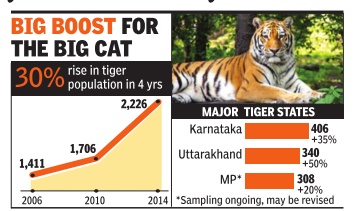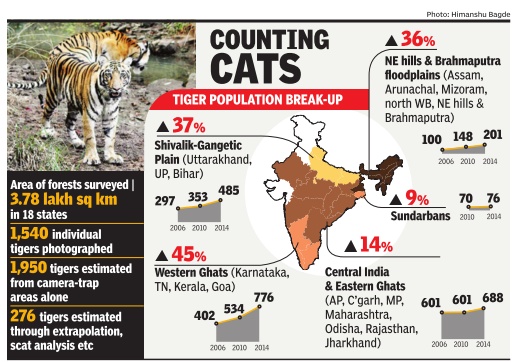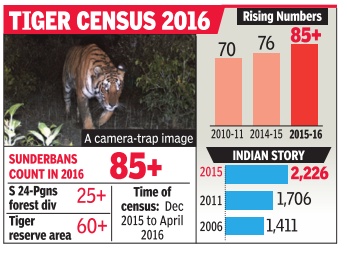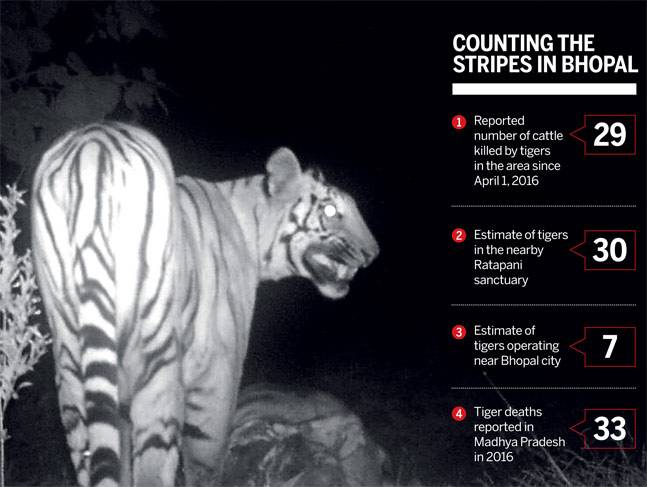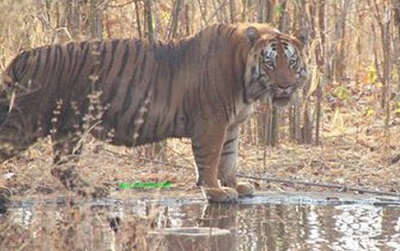Tigers: India
(→2019: spotted in Boriya, Gujarat) |
(→2006-2018: tigers almost double) |
||
| Line 53: | Line 53: | ||
[https://timesofindia.indiatimes.com/city/nagpur/over-2600-tigers-in-country/articleshow/70411904.cms Vijay Pinjarkar, July 28, 2019: ''The Times of India''] | [https://timesofindia.indiatimes.com/city/nagpur/over-2600-tigers-in-country/articleshow/70411904.cms Vijay Pinjarkar, July 28, 2019: ''The Times of India''] | ||
| − | [[File: 2006-18, the number of tigers in India; The reasons for the increase.jpg|2006-18, the number of tigers in India <br/> The reasons for the increase <br/> From: [https://timesofindia.indiatimes.com/city/nagpur/over-2600-tigers-in-country/articleshow/70411904.cms Vijay Pinjarkar, July 28, 2019: ''The Times of India'']|frame|500px]] | + | [[File: 2006-18, the number of tigers in India; The reasons for the increase.jpg|2006-18, the number of tigers in India <br/> The reasons for the increase; <br/> From: [https://timesofindia.indiatimes.com/city/nagpur/over-2600-tigers-in-country/articleshow/70411904.cms Vijay Pinjarkar, July 28, 2019: ''The Times of India'']|frame|500px]] |
| + | [[File: 2006-18, the number of tigers in India.jpg|2006-18, the number of tigers in India (The previous graphic had provisional figures for 2018; these are the finalised figures.) <br/> India is now home to 75% of the global tiger population. The worldwide population of wild tigers stands at 3,890 with Russia, Indonesia, Malaysia, Nepal, Thailand, Bangladesh and Bhutan being other key countries contributing to the remaining 25% count. <br/> On the down side, three (Buxa, Dampa and Palamau) out of the 50 tiger reserves in the country did not record a single tiger. <br/> From: [https://epaper.timesgroup.com/Olive/ODN/TimesOfIndia/shared/ShowArticle.aspx?doc=TOIDEL%2F2019%2F07%2F30&entity=Ar00512&sk=78061DA3&mode=text Vishwa Mohan, July 30, 2019: ''The Times of India'']|frame|500px]] | ||
| + | |||
| + | |||
| + | '''See graphics''': | ||
| + | |||
| + | ''2006-18, the number of tigers in India <br/> The reasons for the increase '' | ||
| + | |||
| + | '' 2006-18, the number of tigers in India (The previous graphic had provisional figures for 2018; these are the finalised figures.) <br/> India is now home to 75% of the global tiger population. The worldwide population of wild tigers stands at 3,890 with Russia, Indonesia, Malaysia, Nepal, Thailand, Bangladesh and Bhutan being other key countries contributing to the remaining 25% count. <br/> On the down side, three (Buxa, Dampa and Palamau) out of the 50 tiger reserves in the country did not record a single tiger. '' | ||
''' Has the tiger population risen by 20% to cross 2,600? ''' | ''' Has the tiger population risen by 20% to cross 2,600? ''' | ||
| Line 94: | Line 102: | ||
[[Category:Law,Constitution,Judiciary|T TIGERS: INDIATIGERS: INDIATIGERS: INDIATIGERS: INDIATIGERS: INDIATIGERS: INDIATIGERS: INDIA | [[Category:Law,Constitution,Judiciary|T TIGERS: INDIATIGERS: INDIATIGERS: INDIATIGERS: INDIATIGERS: INDIATIGERS: INDIATIGERS: INDIA | ||
TIGERS: INDIA]] | TIGERS: INDIA]] | ||
| − | [[Category:Pages with broken file links|TIGERS: INDIA]] | + | [[Category:Pages with broken file links|TIGERS: INDIATIGERS: INDIA |
| + | TIGERS: INDIA]] | ||
== Uttar Pradesh: an increase== | == Uttar Pradesh: an increase== | ||
Revision as of 11:44, 26 January 2021
This is a collection of articles archived for the excellence of their content. |
Population
1999-2015: Population

From: The Times of India
See graphic:
Population in India, wild tiger:1999-2015
2006-2014: High growth
Jan 21 2015
2,226 now: Tiger numbers grow by 30% in 4 years Camera trap and DNA sampling methods used in tiger census
Vishwa Mohan
There are more than 2,200 tigers in India's forests, the latest census reveals, indicating a sharp 30% rise in four years that'll come as a big boost to India's conservation efforts. The census, held in 2014, found evidence for 2,226 tigers, compared to 1,706 in 2010.
The southern states of Karnataka, Tamil Nadu and Kerala in the Western Ghats landscape recorded nearly one-third of the country's total number of big cats. Karnataka continues to have the highest number of tigers in India, itself home to 70% of the world's tiger population.The Mudumalai-BandipurNagarhole-Wayanad forest complex in Western Ghats holds the world's largest tiger population, with 570 tigers. If one compares the 2006 tiger census, when mod ern methodology was adopted for the first time, revealing a tiger population of just 1,411 -the overall increase across the country is a phenomenal 800-odd tigers in the past eight years.
Releasing the 2014 data on Tuesday , Union environment and forests minister Prakash Javadekar said, “We must be proud of our legacy . We have increased the number of tigers by over 30% from the last count (in 2010). “ A total of 3,78,118 sq km of forest area in 18 states, having tiger population, was surveyed during the census that used `double sampling' approach including ground survey and remote camera trapbased capture and recapture technique. Besides, scat DNA sampling method was also used for corroboration in many forest areas.
More than 9,730 cameras were used in the exercise, carried out by National Tiger Conservation Authority in collaboration with the state forest departments, national conservation NGOs and Wildlife Institute of India.
The exercise resulted in 1,540 individual tigers being photographed -making it the most authentic report on tiger population in the country.
The report shows that the tiger population has increased in Karnataka, Utta rakhand, Madhya Pradesh, Tamil Nadu and Kerala in the past four years, while it has decresed in Odisha and Jharkhand.
2006-14, number of tigers in India

From: January 29, 2019: The Hindu
See graphic:
Number of tigers in India- 2006-2014
2006-2018: tigers almost double
Vijay Pinjarkar, July 28, 2019: The Times of India
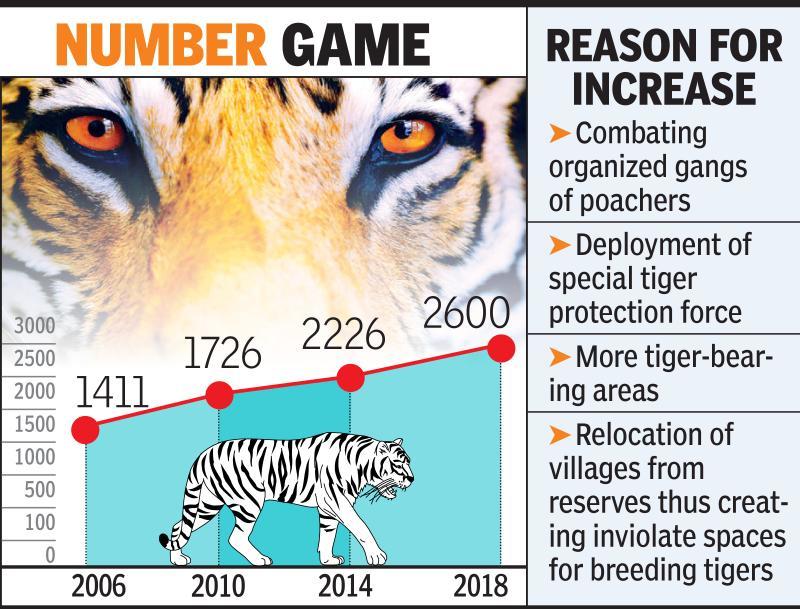
The reasons for the increase;
From: Vijay Pinjarkar, July 28, 2019: The Times of India

India is now home to 75% of the global tiger population. The worldwide population of wild tigers stands at 3,890 with Russia, Indonesia, Malaysia, Nepal, Thailand, Bangladesh and Bhutan being other key countries contributing to the remaining 25% count.
On the down side, three (Buxa, Dampa and Palamau) out of the 50 tiger reserves in the country did not record a single tiger.
From: Vishwa Mohan, July 30, 2019: The Times of India
See graphics:
2006-18, the number of tigers in India
The reasons for the increase
2006-18, the number of tigers in India (The previous graphic had provisional figures for 2018; these are the finalised figures.)
India is now home to 75% of the global tiger population. The worldwide population of wild tigers stands at 3,890 with Russia, Indonesia, Malaysia, Nepal, Thailand, Bangladesh and Bhutan being other key countries contributing to the remaining 25% count.
On the down side, three (Buxa, Dampa and Palamau) out of the 50 tiger reserves in the country did not record a single tiger.
Has the tiger population risen by 20% to cross 2,600?
NAGPUR: The tiger population in the country is likely to show a rise of 400, which is an 18-20% hike over the 2014 number of 2,226. Prime Minister Narendra Modi is expected to announce the final figure in New Delhi on Monday, which is Global Tiger Day. People in the know told TOI that it would be in excess of 2600.
The PM will also release the All India Tiger Estimation Report-2018. This is the fourth estimation after Project Tiger was reconstituted in 2006. The national estimation is done every four years. In 2006, the tiger count was 1,411 followed by 1,726 in 2010.
Karnataka is expected to maintain the top slot with 500 tigers followed by Madhya Pradesh and Uttarakhand. The last estimation showed Karnataka had 406 tigers.
Even as Wildlife Institute of India (WII) & National Tiger Conservation Authority (NTCA) officials remained tight-lipped on exact figure, they dropped enough hints to indicate that the “increase is substantial”. “The number was even more than what is going to be announced, but to avoid negative repercussions it has been toned down,” some forest officials told TOI.
Union environment minister Prakash Javadekar will also be present along with Modi when the announcement is made at 9.30am. Chief wildlife wardens of all states and tiger reserve field directors too have been invited. The two-day meet will also release management effective evaluation (MEE) reports of all tiger reserves.
Explaining the increase in tiger numbers, officials said this time they refined the methodology by reducing the sampling effort from 4sqkm to 2sqkm to get more accuracy.
“We have 90% pictures of the estimated tiger numbers. More sampling areas were added in more areas which were not covered earlier. Hence, detection probability also increased,” they said.
“In Maharashtra, we estimate an increase in tiger numbers between 230-240,” said officials involved in data collection process. In 2006, there were 103 tigers, followed by 169 in 2010 and 190 in 2014.
In the 2014 estimation, there were 66 tigers in Tadoba and Andhari Tiger Reserve core and buffer, but now the number has gone up to 86. “Similarly, Pench Tiger Reserve, which recorded 23 tigers in 2014, has shown 38 tigers. Melghat Tiger Reserve numbers are also expected to rise,” said officials.
Tigers are being ‘recorded’ in new places. “Today, there are two tigresses with cubs inside Chandrapur Thermal Power Plant premises. Areas surrounding Pench, Tipeshwar (Yavatmal) and Bor (Wardha) too have become source areas. Tigers have staged a comeback in parks like Navegaon (Gondia-Bhandara) where there were none over a decade ago.”
In Brahmapuri near Tadoba, though the tiger number has gone down from 44 in 2017 to 40 this year, the number increased in Central Chanda. Besides, between 2014 and 2018, several tigers have dispersed in search of new territories indicating their occupancy has increased.
Critics say the estimation methodology has been “messed up” by placing 1 camera every 4-5 sq km to 2 sq km. “This means double the effort, huge data and more importantly reduction of sampled area due to limited number of cameras. This will cause reduction in even minimum number of tigers and sample size,” they argued.
The All India Tiger Assessment 2018 is expected to give more accurate results as this was the first tiger census where volunteers and foresters used a digital app to record their observations. The app, M-STrIPES, is an integrated programme for GPS-aided spatial patrolling and ecological assessment of tiger reserves.
Critics, however, felt that the M-STrIPES is still not stable in several reserves. Testings have not been properly done and it is crashing. The ecological monitoring latest version was launched in December last year and estimation was conducted in January giving frontline staff little time to get trained and equipped. Moreover, till date mobile phones have not been supplied in most tiger reserves.
“There is definitely data fudging where old photographs of tigers were used for the purpose of the report and a cumulative figure is given as number of tigers actually captured,” they alleged.
Uttar Pradesh: an increase


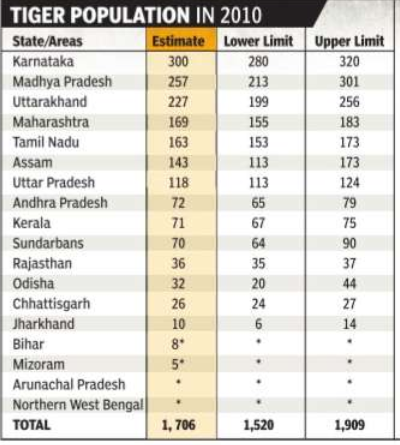
Rise in No. of tigers in Uttar Pradesh
The Times of India TNN | Jul 27, 2014
LUCKNOW: Camera traps have shown more tigers in the core area of Dudhwa tiger reserve this time. The initial estimates for two years, 2011 to 2013, have shown 72 to 80 tigers in the core area of the reserve.
Tiger census 2010-11 had counted 118 tigers in Dudhwa reserve. "The final count this time might be around 125," said PCCF (wildlife), UP, Rupak De.
The findings have been sent to the Union ministry of environment and forest for screening, said the official.
Camera-trapping exercise has been done for Kishenpur wildlife sanctuary and Dudhwa national park which form core of the reserve. Initial findings have also come for Pilibhit forest division which is now a separate reserve.
In all, 72 to 80 tigers have been counted in these areas. Once figures for Katarniaghat wildlife sanctuary, North and South kheri forest division come, tiger numbers might go up to 125. The improved census technique could have resulted in more tigers getting recorded in camera.
It was an 'intensive' exercise as a pair of cameras was installed every 1.6 sq km of the core area. A pair of cameras was installed at 65 identified points in Kishenpur and at 206 identified points in Dudhwa national park.
The height at which cameras were mounted was also altered to record cubs, two-year old and less.
About a dozen new cubs have been recorded in camera.
At least 382 photographs have been downloaded from cameras installed in Kishenpur and Dudhwa national park.
Many of these photographs, said officials, could be 'repetitions' which is why the photographs would be screened. Tiger census is on since November 15 in the reserve.
UP has a major tiger population in Dudhwa tiger reserve comprising Dudhwa National Park (680 sq km), Kishenpur Sanctuary (204 sq km) and Katarniaghat Wildlife Sanctuary (440 sq km); Pilibhit (720 sq km); North Kheri (350 sq km) and South Kheri (460 sq km).
Smaller tiger populations are present in Bijnor forests in west and Suhelwa (Gonda-Bahraich) and Sohagibarwa wildlife sanctuaries (Maharajganj) in east.
2010-2016, a rise of 22%
The Times of India, Apr 12 2016

Tiger population up 22% in 6 years
Vishwa Mohan
After decades of constant decline, the world has for the first time seen an increase in the global tiger population. The number of tigers in the wild has increased from 3,200 in 2010 to 3,890 in April this year -an increase of nearly 22% -with India continuing to be home to the highest number of big cats.
The latest figures of global tiger population were released on Monday on the eve of the third Asia Ministerial Conference on tiger conservation. The three-day mega meet will be inaugurated by PM Narendra Modi in New Delhi on Tuesday .
The number of tigers will turn out to be even more once one of the tiger range countries, Myanmar, comes out with its latest data. Myanmar had 85 tigers roaming its jungles in 2010.Since there is no recent data available for the country , the `Global Wild Tiger Status' report has not included the country's figure in the overall global figure.
The updated minimum figure is compiled from International Union for Con servation of Nature (IUCN) data and the latest national tiger surveys. The report has attributed the increase in world tiger population to multiple factors including increases in tiger populations in India, Russia, Nepal and Bhutan, improved surveys and enhanced protection. India alone recorded an increase of over 500 tigers during the period.
Speaking about India's efforts to conserve tiger, Union environment and forests minister Prakash Javadekar said, “We have allotted Rs 380 crore to Project Tiger in the current fiscal year, which is an all-time high. It indicates that the government is committed to the conservation of our national animal tiger“.
It was agreed in 2010 Tiger Summit in Russia to double the number of tigers by 2022. The goal is known as Tx2.
2012-16: Rising population
The Hindu, January 1, 2017
Statistics provided by the official database of the National Tiger Conservation Authority (NTCA) show that the death toll of wild tigers in the country was 97 in 2016, the highest among the annual death figure of the big cat in five years from 2012 to 2016. In 2015, there were 70 wild tiger deaths, in 2014 it was 66, in 2013, 63 and in 2012, 72.
The wild tiger toll in 2016 began with three deaths reported on January 2 from three different States, Aassam, Maharashtra and Madhya Pradesh. The last one in 2016 was reported on December 28 at Sehore district of Madhya Pradesh. A whopping 30 wild tiger deaths were reported from Madhya Pradesh alone in 2016.
Karnataka followed with 17 deaths and Maharashtra with 15 wild tiger deaths last year. Among the deaths, only 18 were due to natural causes. Four deaths were caused by poisoning, 12 deaths due to infighting between tigers and one each caused by drowning, electrocution and poaching. The poaching was reported from the Chikmagalur territorial division of Karnataka.
Two tigers, one at Gudalur in Tamil Nadu and the other at Corbett National Park, Uttarakhand, were “eliminated” by authorities following conflict with man. The NTCA data says that cause of death of the remaining tigers was awaited.
On March 28, 2016, three tigers were found dead due to poisoning at the Satosha beat area of Pench National Park in Madhya Pradesh. The highest number of wild tiger deaths was in April — 12, and in that month five deaths were reported from Madhya Pradesh.
The country lost four tigers on April 26, three tigers on December 8 and two tigers each on January 21, April 2, April 8, May 7, November 4 and November 24.
Uttarakhand, sightings: 2016
The Times of India, Aug 04 2016
Another tiger sighted at 14,000ft in Uttarakhand
Days after the Uttarakhand forest department said there were sightings of a tiger at a height of 12,000ft in the Askot wildlife sanctuary in Pithoragarh, the first time the presence of a wild cat was recorded at such altitudes anywhere in the country, there came reports of another tiger sighting at an altitude of 14,000ft, this time at Kapni Tal, a high-altitude lake in Kedar valley.
The divisional forest officer (DFO) of the area claimed that camera trap images of a tiger in the area had been recorded and sent for further studies.
However, senior forest officials said further confirmation of the sighting -and whether it took place at the altitude specified -was needed before the presence of another big cat at high altitude could be confirmed. The news of the sighting in the upper reaches of Garhwal coming as it did after the one at Kumaon immediately sent interest levels soaring although officials continued to evade questions on the validity of the camera-trap images.
Meanwhile, DVS Khati, the chief wildlife warden, said that it was not clear whether “the camera trap image of the tiger is from the Kedarnath Wildlife Sanctuary or anywhere else.“
2016: Nameless tigers are ‘numbered’
The Times of India, Jun 04 2016
Sixteen `nameless' tigers, half of them not spotted for months, in Rajasthan's Ranthambore national park have been numbered for tracking and subsequent mo nitoring. The numbers were assigned to these adult tigers, most of them at least two years old, on the basis of trap camera footage. Ranthambore was the first national park in the country that began assigning numbers to tigers on the basis of photos from cameras set up across its territory. In 2009, the numbers assigned were from T-1 to T-45. In 2013, the new number were from T-46 to T-75. Now, 16 more numbers have been added.
2016: Tiger cub boom
The Times of India, Jun 16 2016
Rachna Singh
Tourists are enjoying a baby boom at Rajasthan's Ranthambhore Tiger Reserve with only a fortnight to go before it closes. The national park remains open to visitors as per safari timings from October 1 to June 30 every year.
Wildlife lovers are elated as the area has for a long time been devoid of any tigers. While a tiger named T 5 died recently , T 17 disappeared mysteriously .Also, two tigers from this area were shifted to Sariska Tiger Reserve.
Conservationists say there should be a special emphasis on protection of the cubs as the area where they were sighted faces threat from the illegal mining lobby, grazing and the pilgrim rush at a nearby temple.
The tiger reserve has 43 adults, 25 male and 18 female, and 19 cubs, taking the total number to 62.
2016: Tiger count in Sunderbans rises to 85
The number of big cats in the Indian Sunderbans is healthy and rising. A recent camera-trap exercise has spotted at least 9 more tigers over last year's figures in the entire mangroves, including the tiger reserve area and the South 24-Parganas forest division.
The assessment exercise by the ministry of environment and forests (MoEF) and Wildlife Institute of India (WII) had in 2015 put the total tiger count in the Sunderbans at 76. This year, state foresters have put the number at more than 85 on the basis of camera-trap images, but claim the number could be more since it is not possible to photograph all the big cats using camera traps.
This development, along with the recent sightings of otters, indicate a revival of health of the Sunderbans, the world's largest mangrove forest spanning two countries.
This is the first time that the camera-trap exercise covered the entire Indian side of Sunderbans -the tiger reserve area and the forests outside. The exercise was completed jointly by WWF India and the state forest department.
While chief wildlife warden Pradeep Vyas refused to divulge details and restricted himself to saying that a “report had been prepared and would be submitted next week“, sources in the know claimed that at least 25 tigers, including a cub, were found outside the reserve area or the South 24-Parganas forest division. The remaining 60 were spotted inside the tiger reserve area.
The camera-trap images were analysed with the help of a special software that matched the stripe patterns of the big cats to arrive at a figure of 85, the sources explained. The same exercise last year had projected the cat population in the mangroves at 76.
Earlier, TOI had highlighted how a data-collection exercise has revealed that the population of swamp tigers is on the rise even outside the Sunderbans Tiger Reserve (STR), a protected area.
An official said the recent sightings also show that the population inside the STR area is healthy . In September, a mating pair was sighted in a forest within the tourism zone of Sajnekhali.
Tigers were also reportedly sighted by tourists during monsoon and Durga puja.Movement of a big female and two cubs has also been reported from the Sajnekhali tourism zone which is spread over 362 square kilometres.The tourism zone covers forests like Pirkhali, Dobanki and Panchamukhani.
The camera-trap exercise, that was started in December 2015 in the South 24Parganas forest division, was completed in April 2016 at the Basirhat range that falls in the STR zone.
A similar report released by the state forest department in 2013 had predicted the presence of at least 101 tigers in the mangroves. On being asked about that, a forester said that a refined technology used this time gave a more reliable figure.
“Besides, the cubs were not taken into account. And, as we said earlier, we can't expect all the tigers to appear before the cameras. So the numbers can be even more,“ he added.
2016, Madhya Pradesh: a decline
The Indian Express, January 2, 2017
The year 2016 was not for tigers as death toll in Madhya Pradesh touched 33
On an average, 14 tigers had died every year from 2012 to 2015, but the death toll went up to an alarming level of 33 in 2016.
Once a home to tigers, Madhya Pradesh now appears to have turned into an enemy territory for them, as the state witnessed the highest number of feline deaths in 2016, when it lost 33 big cats, taking the toll to 89 in a period of last five years. From year 2011 to 2016, as many as 89 tigers including 11 cubs died in the state due to various reasons including poaching, territorial clashes or for natural reasons as cited in the data obtained from the MP Forest Department.
The data revealed that 2012 witnessed the death of 16 felines which reduced to 11 next year (2013). Subsequent years proved more fatal for the wildcat when the state saw 14 and 15 deaths respectively in 2014 and 2015. And, then came 2016, the worst of all when the figures (of feline deaths) were almost double the average of previous five years.
On an average, 14 tigers had died every year from 2012 to 2015, but the death toll went up to an alarming level of 33 in 2016. As far as reasons are concerned, the death of 30 out of 89 tigers were attributed to the territorial clashes, while 22 of them have fallen prey to poachers, who killed them either by poisoning or through the electrocution.
The remaining 37 tigers are cited to die either due to their old age, illness or some other reasons. Amid all these dismal reports about dwindling wildcats’ population, state forest authorities claimed that there was some encouraging news too for tiger conservationists. The state has recorded a growth in their population as more cubs were born during this period. “The tiger population was reduced to 257, according to the census carried out by the National Tiger Conservation Authority (NTCA) in 2011. However in 2014, the tiger population in the state has gone up to 308,” MP’s Principal Chief Conservator of Forest (PCCF), Wildlife, Jitendra Agrawal told PTI. Agrawal claimed that there are 216 tigers in only six tiger reserves of the state – Kanha, Bandhavgarh, Pench, Panna, Satpura and Sanjay National Park. “In addition to these tiger reserves, there are a number of tigers in other forests of the state. If cubs are included, the number of tigers may go beyond 400. This data is an evidence of ongoing conservation work,” he added.
He claimed that the data of union government also denotes that the number of tigers in Madhya Pradesh are rising gradually over the years.
2017: Increase in Uttarakhand
[epaperbeta.timesofindia.com/Article.aspx?eid=31808&articlexml=Big-jump-in-tiger-count-in-Ukhand-27072017017025 Sharma Seema|Big jump in tiger count in U'khand|Jul 27 2017 : The Times of India (Delhi)]
Tiger numbers have swelled in reserves of Uttarakhand with both Corbett Tiger Reserve and Rajaji Tiger Reserve registering an increase in the population of the animal in the latest census, results of which were announced by chief minister Trivendra Rawat on Wednesday .
According to the tiger estimation exercise, Corbett now harbours a minimum of 208 tigers, a rise from 163 in 2015, while Rajaji is home to 34 big cats, up from 16 in 2015. Forest department officials have attributed the increase in tiger numbers to enhanced security measures undertaken in the recent past.
The census, which esti mated the minimum number of tigers, was based on camera trap method and was conducted as per National Tiger Conservation Authority protocols.
The tiger count started on November 28, 2016 and ended on March 19. In Corbett, 535 camera traps were set up in the 1,318 sq km area of the reserve. The World Wide Fund for Nature (WWF) collaborated with forest department officials to carry out the exercise.
2018
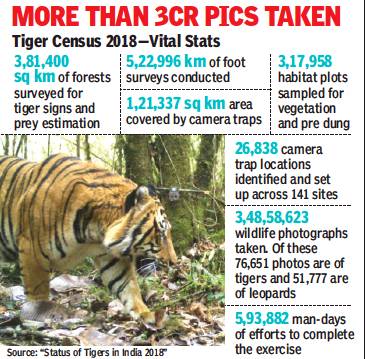
From: ‘Largest-ever camera trap wildlife survey’ puts India in record books, July 12, 2020: The Times of India
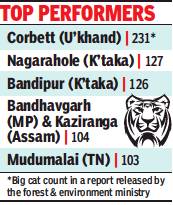
From: Shivani Azad & Keshav Agrawal, Corbett tops in tiger count, MP pips K’taka, July 29, 2020: The Times of India
See graphic:
The results of the 2018 Tiger Census
Jim Corbett national park in Uttarakhand has the most number of tigers in the country, with 231 of the 2,967 big cats counted for the ‘Status of Tigers, Copredators & Prey in India’ report released by Union forest and environment minister Prakash Javadekar.
Corbett’s tiger count has been rising — from 137 in 2006 to 174 in 2010 and 215 in 2014. “We had expected the numbers to be over 250,” said director of the reserve, Rahul. It is followed by Nagarhole (127) and Bandipur (126), both in Karnataka, Bandhavgarh in MP (MP) and Kaziranga in Assam (104 each). Among states, MP topped the tiger estimation, with 526 (it had 308 last time), going past Karnataka (524 this time, 406 earlier).
UP’s Sohagi Barwa gets a lone tiger
Uttarakhand remained on the third spot, with 442 tigers, up from 340 previously. The All India Tiger Estimation is undertaken every four years, the latest in 2018. This time, Corbett is the only reserve with more than 200 tigers and has the highest tiger density in India, 14. The count in Dudhwa Tiger Reserve has also gone up. “It is a an increase from 58 to 82,” said Sanjay Kumar Pathak, field director of the reserve. Pilibhit reserve’s population is also up by two to 57. And what used to be a non-tiger zone in UP, Sohagi Barwa Wildlife Sanctuary, now has one tiger. But Mizoram’s Dampa reserve and Bengal’s Buxa lost the 6 tigers they had between them. Full report on www.toi.in
2019: spotted in Boriya, Gujarat
Himanshu Kaushik, Tiger spotted in Guj after 27 yrs, February 10, 2019: The Times of India
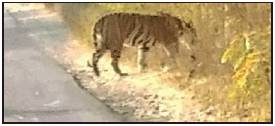
From: Himanshu Kaushik, Tiger spotted in Guj after 27 yrs, February 10, 2019: The Times of India
Twenty-seven years after a tiger was last sighted along the Dang border in Gujarat in 1992, a government teacher has reported seeing a tiger, kicking off a discourse that tiger has finally returned to Gujarat.
The teacher, Mahesh Mahera, who sighted the tiger crossing a road into the wilderness of Boriya village in Mahisagar district, also captured the big cat on his mobile phone.
The pictures, clicked from inside his car on February 6, went viral with the state forest department on Saturday setting up camera traps in the vicinity of Boriya village to get more evidence of the tiger’s presence. “While returning home from school in the evening, I was shocked to see a tiger just 40-feet away from my car. As locals have been talking about a tiger’s presence in the area, I immediately clicked its pictures,” said Mahera, who teaches in a primary school in the area.
Mahera shared the pictures with his friends who alerted the forest officials. On Saturday, the picture landed on the mobile of principal chief conservator of forest (PCCF) Akshay Saxena, who ordered an intensive search operation. He has also asked the officials to check authenticity of the pictures.
“We are looking for scat (tiger feces), pug marks, big animals killed. Three camera traps have been mounted and more will be placed soon to capture visual evidence of the tiger,” said Saxena. The PCCF said if tiger’s presence is confirmed in Gujarat, the department will have to go back to drawing board to redesign a wildlife conservation programme for big cats.
Gujarat government confirms tiger’s presence
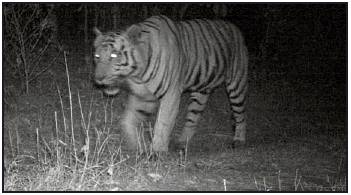
From: Himanshu Kaushik, It’s official: Tiger has entered lions’ kingdom, February 13, 2019: The Times of India
It’s officially confirmed now. A tiger has indeed entered the lions’ den in Gujarat — which is home to the Asiatic lion’s last abode.
Six days after a school teacher clicked a tiger on his mobile phone, the striped big cat was captured on Tuesday morning in the advance night vision cameras especially mounted by the forest department in the area. “Our cameras spotted the tiger in forest area 2 km away from Santrampur in Panchmahal district. The tiger is an adult, aged 5-7 years with pug-marks of 15-17cm diameter,” said RM Parmar, deputy conservator forest of Mahisagar district, who was in-charge of the search mission to locate the tiger following its sighting by teacher Mahesh Mahera.
The return of the big cat to Gujarat after 27 years — it was last spotted in Dangs in 1992 — brought elation in the wildlife circuit. “With the sighting of the tiger, Gujarat is now the only state in the country to have the lion, tiger and leopard,” said principal chief conservator of forest (wildlife) AK Saxena.
The PCCF said that the department is keeping a close watch on the tiger’s movement to ascertain if it is a guest from MP or Maharashtra or is a permanent resident, having made the Gujarat jungle its home.
Forest minister Ganpat Vasava said that Gujarat welcomes the tiger’s presence and may develop a tiger corridor. “The state forest department has sought expert assistance from the Centre. We have also alerted MP, Rajasthan and Maharashtra from where the tiger could have come into Gujarat,” said Vasava.
Saxena said the state will now have to include tiger in its wildlife plan. “We will be mandated to ensure an adequate prey base in the area and preserve the corridor from where it enters the state,” the PCCF said.
Population, state-wise
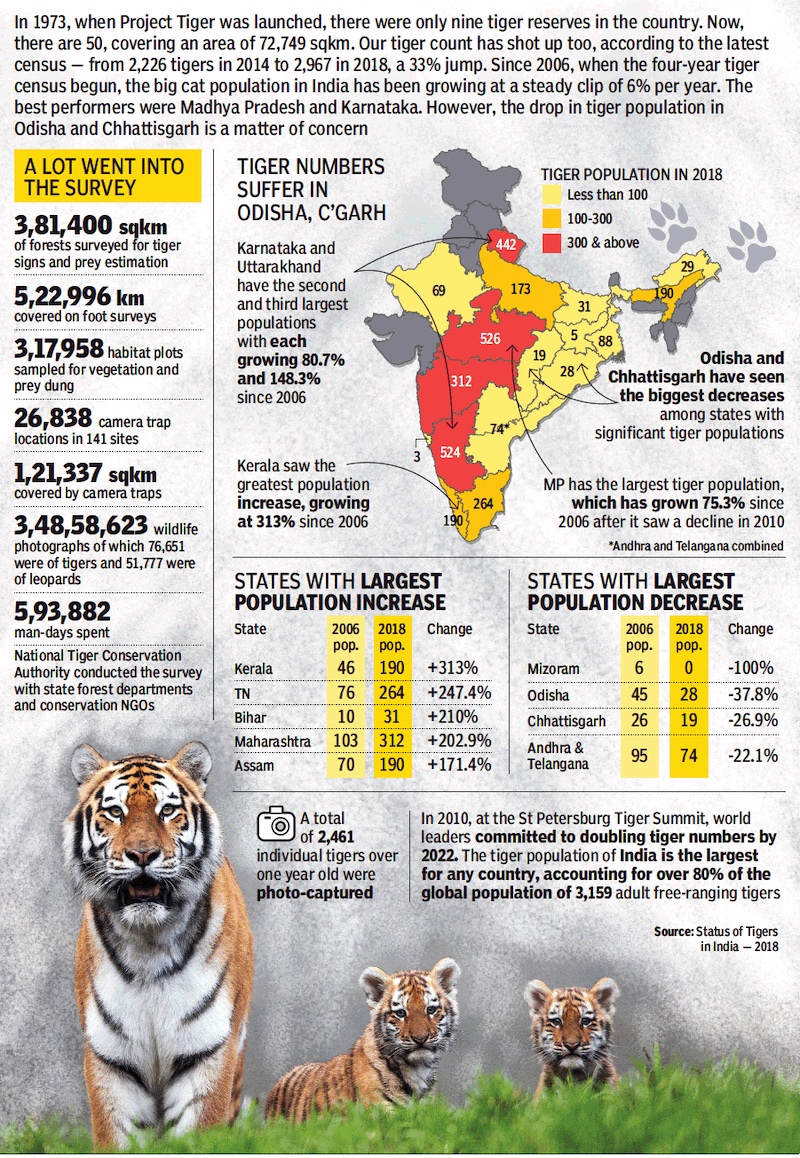
State-wise, 2018.
From: July 30, 2019: The Times of India
See graphic:
The Population of tigers in India, 2006-18
State-wise, 2018.
Tiger reserves
Tiger corridors
Central India

From: Vijay Pinjarkar, Wildlife scientists identify 567 types of barriers in 30 tiger corridors in central India, October 16, 2018: The Times of India
A study by three wildlife scientists has identified 567 types of barriers in 30 corridors in central India landscape consisting of 3,84,508 sqkm spread across 16 protected areas (PAs) in Madhya Pradesh, Maharashtra and Chhattisgarh. It contains 16 PAs with a size of 87 sqkm to 3,188 sqkm.
Central India is a global-priority landscape for tiger conservation and contains about 31% of India’s tiger population. The study mapped these corridors and ranked them according to their restoration potential.
“We mapped 567 barriers within 30 linkages in this landscape of which 265 barriers intersect with infrastructure and include 694km of roads, 150km of railway, 48 reservoirs, and 10 mines. Besides, 302 barriers are due to landuse or gaps in forest cover,” says lead author of the study Trishna Dutta, Department of Ecology, Evolution, & Environmental Biology, Columbia University, New York.
Co-authors Sandeep Sharma and Ruth DeFries say, 86 barriers have both roads and railways and there are 80 surface mines and thermal power plants within 10km of the least-cost paths (a path that would be easier for animals to traverse through) and more coal mines are closer to connectivity areas where linkages are narrow.
The study found that 567 barrier area contained agriculture (1,260 sqkm), forest (1,821 sqkm), degraded cover (1,183 sqkm), open-water (150 sqkm), barren land (17 sqkm), and settlements (15sqkm).
“In many cases, avoiding the new infrastructure through critical areas, removing or building mitigation structures across existing barriers, or restoring the degraded habitat along corridors may provide an economically viable alternative to more traditional conservation actions such as land acquisition,” they told TOI.
Sharma from Smithsonian Conservation Biology Institute, USA, said for a tiger, a path (corridor) comprising of intact forest would be easier to traverse through than an open crop field, than a path going through barriers like towns, mines, and roads.
“So lower the least-cost path (LCP) distance, the better it is for tiger movement. We found that of all the 16 PAs, corridors between Kanha-Pench, Satpura-Melghat, Kanha-Nagzira, Nagzira-Pench, and Pench-Umred-Tadoba have high quality and potential for tiger connectivity and should be maintained. But, the best among these is Kanha-Pench corridor. Corridor between Satpura-Ratapani was poorest,” said Sharma.
Kanha-Pench corridor was selected as the best based on several different analysis that not only include quality and width of the corridor but also consider the tiger density of the reserves in evaluating the corridor. “The novelty of study from what have been done and published in the past, is that we not only ranked the corridors based on their structural and functional potential but we also map and locate various types of barriers (roads, railway, mines, dams etc) within these corridors and provide suggestions as an improvement potential, which I hope has an implication value for restoration and conservation of these corridors,” says Sharma.
Maha govt diverts tiger land for explosives co.
Vijay Pinjarkar, October 30, 2018: The Times of India

From: Vijay Pinjarkar, October 30, 2018: The Times of India
At a time when man-animal conflicts are a regular occurrence in Maharashtra and 26 people have been killed in the past 10 months in the state, Maharashra’s Forest Advisory Committee (FAC) has given an “in-principle clearance” for handing over 87.98 hectare tiger-bearing forest to an explosives company, Solar Industries India Ltd (SIIL), in Chakdoh for manufacturing defence products.
Also, though the 222-acre reserve and protected forest land at Chakdoh in Kondhali and Kalmeshwar ranges, 40km from Nagpur, is valued at over Rs 100 crore at current market rate, SIIL will get it for a mere Rs 7.09 crore. The company will spend Rs 7 crore on compensatory afforestation and fencing the land. The FAC decision was passed in 2017.
Of the 88-hectare forest to be diverted, 26-hectare fall in Kalmeshwar range and 62 in Kondhali. According to forest officials, one cattle kill is reported every week both in Kondhali and Kalmeshwar ranges. Besides, annually at least 200 cropdamage cases are reported indicating there is sizeable number of herbivores.
As per survey reports, there is presence of six tigers, including two males and females with cubs, and an equal number of leopards besides spotted deer, barking deer, wild dogs, wild boars, sambars, nilgai and civets in the area. Presence of these animals has been found within the 5-km periphery of the company’s premises. Being contiguous, animals use the proposed diversion area too.
In 2016, reacting to a series of TOI reports, forest minister Sudhir Mungantiwar had said that if tiger presence is found in the proposed area, the land would not be diverted. Congress MLA from Saoner, Sunil Kedar, in whose constituency the area falls, had vehemently opposed the diversion. On Monday, Kedar expressed surprise over the decision and said, “I’m not aware and will find out from the forest department and come back to you.” He did not call back.
A senior forest official concerned with the issue told TOI the decision was taken with consensus in a joint meeting called by the forest minister in which Kedar too was present. SIIL business director JF Salve said, “We will pay Rs 1crore in five years to the forest department for conservation. A small piece of land will be utilised for manufacturing critical defence products while remaining land is needed for safety distance. Some of the area will also be fenced.”
Tiger reserves, state-wise
From the archives of India Today , May 28, 2009
Ambreesh Mishra with Mihir Srivastava
The elegantly-worded and detailed website of the Madhya Pradesh Government’s Forest Department has but one missing element—the number of tigers to be found in its numerous national parks, sanctuaries and reserves. Odd, since Madhya Pradesh is considered India’s tiger country.
Not odd at all though, if you take into account its dismal recent conservation record—and the unfortunate propensity of authorites to seek refuge in consistent, unyielding denial.
The brutal truth, however, goes nowhere, even while the opposite happens to the state’s tigers. Four years ago, Sariska National Park in Rajasthan became the metaphor for the decimation of India’s national animal. The nightmare has now shifted location to Panna National Park in Madhya Pradesh.
A Special Investigation Team (SIT) sent by the National Tiger Conservation Authority (NTCA) to probe reports of the disappearance of tigers from Panna confirmed early this month that there weren’t any male tigers left in the once-thriving tiger reserve. In a belated face-saving move, the state Government last week transferred directors of three national parks, including L.K. Chaudhary of Panna.
The directors of Bandhavgarh and Kanha parks have also been transferred. It seems a cosmetic exercise though, as Chaudhary was posted only in August 2008. According to the Central SIT, the park was already devoid of the big cats by that time.
The 2002 tiger census reported that Panna had 20 tigresses, 14 tigers and a cub. In 2004, a CBI inquiry confirmed that all tigers in Panna were dead even as forest officials maintained that the striped cats were very much alive.
In April 2004, Belinda Wright, head of the Wildlife Protection Society of India, filed a writ petition with the Central Empowered Committee constituted by the Supreme Court. She highlighted the alarming loss of tiger population in the park due to poaching, extensive burning and quarrying.
After the Sariska tragedy hit the headlines, the Madhya Pradesh Forest Department had claimed in December 2005 that according to their last count in March that year, there still were 34 tigers in the park. P.K. Sen, the SIT’s chief, however, suspects that tigers may have vanished from Panna altogether by the end of 2008. In March 2009, two tigresses were transported to Panna from Bandhavgarh and Kanha parks after being tranquilised. Wildlife officials were hoping to find mates for the lone surviving tiger in the reserve. Their drive to promote breeding in Panna was futile once it became clear that the ‘lone surviving’ tiger in Panna’s wilderness had not survived the cull.
Late in April, a SIT team made up of S.P. Yadav, Joint Director of NTCA, and Qamar Qureshi, senior scientist of the Wildlife Institute of India (WII), Dehradun, held extensive public hearings in villages and dwellings around Panna National Park. The denial by locals about tiger sightings flew in the face of the claims by authorities about the presence of the lone male tiger in Panna.
The 2002 census, based on pug mark identification, stated that there were three tigresses for every 100 sq km in Panna. Then in 2006, a census revealed there were three tigers for each tigress, an alarming reverse, technically impossible within such a short time. In May that year, locals reported being unable to sight even one striped cat. All the time, forest officials claimed otherwise.
In 2006, wildlife conservationist Raghunandan Singh Chundawat had warned the Government about the dwindling tiger population in Panna.
He was shouted down, with the Government producing its own census figure and claiming that Chundawat was raising the bogey of missing tigers only because he had been slapped with a hefty fine by the Forest Department for the use of an elephant. The animal, the Government said, had been sought for scientific research but was used to shoot a commercial documentary instead.
It is now clear that in Chundawat’s case, Madhya Pradesh wildlife authorities, in a desperate bid to cover up their own sins, were merely shooting the messenger. It worked for four years but the shocking neglect and apathy have finally caught up with the state’s Forest Department.
Early this year, a Ministry of Environment and Forests (MOEF) team found signs of tiger habitation in Panna but failed to sight the big cat. Their experience confirmed the version of local tour operators that tiger sightings had dwindled alarmingly. In March, experts from WII,who were camping in Panna to carry out a census, tentatively confirmed the worst fears of conservationists—at the most only one tiger was left there.
The decision to relocate tigresses from Bandhavgarh and Kanha to Panna was then made, a tacit admission by the department that the big cat had been run out or hunted down from Panna’s forests. A local now says that one of the tigresses brought in to the reserve was already pregnant. This, he says, was a deception devised by forest officials to allow them to claim that there was a male tiger in Panna, when, in his estimation, the last tiger disappeared from Panna in 2008. The reason behind their disappearance was most probably unchecked poaching. If the tigers had left the habitat due to an imbalance in the natural cycle, relocated tigers would leave too.
Even as the NTCA formed the SIT to investigate the Panna episode, the MOEF wrote to the Madhya Pradesh Government, suggesting that a committee be formed to probe the tiger disappearances from Panna. Meanwhile, the state Government is targeting Sen for allowing the news of the purge of Panna into the public domain. Rather than introspect on his department’s negligence, Additional Chief Secretary, Forests, Prashant Mehta, has written to the Centre, complaining that the SIT shouldn’t have made such disclosures publicly. The messenger has already been shot.
The Wildlife Crime Control Bureau, created at the behest of Prime Minister Manmohan Singh by amending the Wildlife (Protection) Act, 1972, has seemingly failed to rein in poaching and related offences. A year after it was founded on June 6, 2007, the bureau is still grappling with manpower issues. Against a sanctioned staff of 110, only 25 personnel have been recruited. Rina Mitra, chief of the bureau, says, “It has been a bumpy ride to integrate forest, police and customs officials to combat wildlife crimes.” The state Government has set up a separate probe committee for Panna, which is yet to begin investigations. This slow response reflects the establishment’s attitude to the alarming rate at which the tiger is being hunted down.
The problem continues to grow: there have been six unexplained deaths in the state’s Kanha Tiger Reserve. “Kanha is showing early signs of Panna,” warns Chundawat. Tiger country is slowly but surely losing its stripes.
Fading stripes
• In 2004, it was discovered that Sariska had no tigers. By 2008, all big cats were gone from Panna. • The last tiger census of 2005 put the number of tigers in Panna at 34. • A special investigative team found that officials had tried to camouflage the truth about Panna. • There have also been six unexplained tiger deaths over the past six months in Kanha.
Buxa Tiger Reserve, West Bengal: "No sign of tigers"
Apr 27 2015
Krishnendu Mukherjee
The Wildlife Institute of India (WII) scientists who conducted a nationwide tiger census over four years have stated in their final report that they found no sign of tigers in the north Bengal park.
“Though two tigers were identified in Buxa on the basis of scat-based DNA, our research team has found no tiger sign in the forest,“ says the report, which was recently submitted to the ministry of environment and forests According to the findings, the Buxa tiger population is “declining“ and needs special attention. The Dehradun-based research institute has also questioned the authenticity of the scat samples sent to it by the Bengal forest department.“We took the GPS coordinates of the scat samples from the state foresters and sent our research team there,“ said Y V Jhala, a senior scientist at the institute. “But the team didn't find any tiger sign in and around those areas. So, we could not authenticate the origin of the scats.“
Earlier, there were allega tions that such scat samples were collected from a wildlife rescue centre located near the tiger reserve. A cameratrap exercise, started in Buxa more than a year ago, has also failed to capture any image of tigers. The same exercise, though, has brought to light the existence of rare and elusive animals such as the clouded leopard, marbled cat and Himalayan serow in the reserve.
A separate study by WII, however, has found the movement of about nine tigers in the corridor between Buxa and Assam's Manas Tiger Reserve.
Ranthambore National Park: Rajasthan
See graphic

CAT-COUNT-3-cubs-born-in-Ranthambhore-tiger
Nov 09 2016 : The Times of India CAT COUNT - 3 cubs born in Ranthambhore, tiger count now at 63 Rachna Singh Jaipur:
While tigers face threats in several habitats across the country , Ranthambhore National Park is falling short of space to house a booming big cat population.
Three more were added to the park's tiger population when tourists on Tuesday morning sighted the newly born litter of Noor aka T-39, which now takes the big cat number in the park to 63. The tigress was sighted with three cubs.
Y K Sahu, field director of Ranthambhore Tiger Reserve (RTR), said this was the first time that three cubs were sighted. “This is the third litter of T-39. Her previous two litters all male adults and sub-adults have been sighted in the Kailadevi area of the park. This is an indication that Kailadevi area is now conducive as a tiger habitat as earlier tigers that had strayed from Ranthambhore to Kailadevi, either came back or strayed into Madhya Pradesh,“ Sahu said.
There are 40-45 adult tigers in RTR. With semi-adults and cubs, the number swells to 63.“The park needs more space for tigers and we have to secure the entire corridor as a safe habitat through relocation of villages. The reason for tigers staying at Kailadevi is because there is less human intervention,“ said Sahu.
Orang National Park, Assam
The Times of India, Mar 02, 2016
`Mini Kaziranga' is India's 49th reserve
Assam's Orang national park, also known as `mini Kaziranga', has become the 49th tiger reserve in the country, with the state government issuing a notification to this effect. The environment ministry has given the nod for three more reserves at Ratapani (MP), Sunabeda (Odisha) and Guru Ghasidas (Chhattisgarh). The conversion of a wildlife sanctuarynational park to a tiger reserve leads to enhanced central funding for a higher level of conservation, which includes a clear demarcation of core and buffer zones in the forest.
Kawal Tiger Reserve, Telangana
The Hindu, December 9, 2016
S. Harpal Singh
Curbs on vehicle traffic through tiger reserve go
Telangana government moves to lift curbs on heavy vehicle traffic movement
Soon after resolving to lift restrictions on vehicular traffic through the Kawal Tiger Reserve, the Telangana government is ironically set to pat itself on the back for its “support” to conservation at the Conference of Parties-13 at Cancun in Mexico.
Environment and Forest Minister Jogu Ramanna, who chaired the meeting of the State Board for Wildlife, where decisions of far-reaching consequences were taken, will attend COP-13 from Friday. He will make a presentation on the government’s efforts to protect the environment.
Among the decisions taken at the meeting was the resolution to lift curbs on the flow of heavy vehicle traffic through the tiger reserve. Environmentalists say the move will nullify all that was achieved in terms of tiger conservation.
In fact, conservationists question the very validity of the meeting as it was not chaired by Board Chairman, Chief Minister K. Chandrasekhar Rao.
“The gaur or Indian bison, now found only in Kawal in entire Telangana, will go extinct,” opined a conservationist as he dwelt on the controversial move. “Restoration of traffic will effectively fragment the core area and the gaurs will die while crossing the road to reach Godavari river, which they do invariably,” he explained.
The bison constitutes the main prey for tigers and its presence gives much hope for tiger conservation. Kawal has about 250 of these wild animals.
‘Alternative route’
“The government can develop the Tapalpur-Kalamadugu road along Godavari as an alternative as it does not disturb the tiger reserve,” suggested former Jannaram Wildlife Divisional Officer G. Rama Krishna Rao.
Lorry traffic will bring back dhaba culture and provide scope for poachers to sell wildlife meat to lorry drivers and others, he said.
Panna Tiger Reserve , Madhya Pradesh
Rahul Noronha , Tiger “India Today” 12/6/2017
From no tigers in 2009 to a saturation point where it can no longer support its tiger population, the Panna Tiger Reserve has come a long way in the intervening eight years. The 542 square kilometre expanse of forest is currently home to more than 30 tigers, a habitat under threat from the proposed Ken Betwa river link project. Tigers brought into the reserve as part of a source population, under the reintroduction programme initiated in 2009, have bred among themselves and reached these numbers.
Another conservation milestone was attained last week when Panna reported the birth of a third generation of tigers. Two tiger cubs were sighted in the Sarbhanga forests of Chitrakoot district in Uttar Pradesh, 125 km from the Panna reserve. The cubs, aged about five months, are said to be the offspring of a tigress from the Panna reserve assigned the call sign P213-22 and a tiger from the reserve who'd made the Sarbhanga forests their home. "The tigers in Chitrakoot are from the F2 generation. The birth of an F3 generation implies that a meta-population (distinct from the source population) is taking shape elsewhere in the landscape away from the area of the reserve. This is a good sign," said R. Sriniwas Murthy, former field director of Panna Tiger Reserve.
Wildlife experts point out that tigers do wander out of their territories, but the moving out of a tigress from a territory it has grown up in suggests the habitat has reached saturation in terms of tiger numbers. Tigress P213-22 moved out of Panna to the Sarbhanga forests in 2015.
2016: First tiger repository, Dehradun
The Hindu, August 7, 2016
Kavita Upadhyay
Country gets its first tiger repository
The Dehradun-based WII has about 23,000 images of tigers. “This has to be maintained and the Tiger Cell will do that,” Dr. Mathur said, adding that “if a tiger skin is recovered at a place then a properly maintained database can be used to check where the tiger might have come from.”Project clearanceThe Tiger Cell could also help with the development-conservation debate. “When a project needs environmental clearance, our spatial data can be used to overlay the project plan on our maps and check whether the project would interfere [with wildlife habitats that must not be disturbed],” WII Director V. B. Mathur said.
“We have worked with the National Tiger Conservation Authority (NTCA) on tiger conservation and population estimation, and in the process we have generated a huge database,” WII Director V. B. Mathur told.
The Tiger Cell was inaugurated and will be funded by the NTCA, a statutory body under the Environment Ministry.
“The Tiger Cell will assist in population assessment of tigers, law enforcement, wildlife forensics, infrastructural development and mitigation, smart patrolling and advisory role in policy formulation,” said Y.V. Jhala, a wildlife scientist at the WII who will head the Tiger Cell.
“We have been working with the Central government for a long time but this is a formal arrangement where we are institutionalising our contribution,” Dr. Jhala said.
2016: MP, first sanctuary for white tigers
The Times of India, Apr 3, 2016
World’s first sanctuary for white tigers opens in MP
Jayashree Nandi
The world’s first white tiger sanctuary has opened at Mukundpur, 20km from Rewa in Madhya Pradesh. Wildlife experts, though, have been critical of white tiger breeding since it has no conservation value.
The 25-hectare sanctuary at Mukundpur, 20km from Rewa, is currently home to only one white tiger, Vindhya. There are two others in an adjoining zoo. Locals in Rewa consider the white tiger — the colour of whose coat is the result of a genetic aberration — a part of the city's legacy. The first such big cat was spotted here by erstwhile king Martand Singh in 1951. The royal family named him Mohan, and he became "a pet, a family member", says Pushpraj Singh, Martand's son. Mohan's cubs were thereafter distributed to zoos in India and abroad. They were reportedly inbred to create a white tiger progeny. But they disappeared completely from Rewa in 1976. It has been a political issue since because locals associate it with their heritage and believe tourism revenue generated from their return can prove a turnaround for a parched city. The sanctuary was inaugurated by Union environment minister Prakash Javadekar and CM Shivraj Singh Chouhan. Javadekar said the sanctuary would bring a "7-star status" to Rewa and promised to set aside funds for a safari. Chouhan added that the project would bring jobs as tourists pour in.
Wildlife experts, though, have been critical of white tiger breeding, and believe it's a waste of money since it has no conservation value. Though the colour of the tiger's coat is admired by many, its camouflaging ability is actually compromised, they point out. "White tigers' are animals afflicted with a a condition known as leucism (partial lack of pigmentation), which can be compared to leucoderma in humans. It is seen in many species including chital and even crows. All the white tigers in captivity are result of systematic, repeated inbreeding of the progeny of a single wild male tiger captured in Rewa the 1950's. Secondly, releasing captive bred tigers into the wilds is an activity fraught with many risks, is expensive, demands massive resources. More often than not these experiments have failed going back over 30-40 years. Therefore, I think this project is not of high priority for deploying scarce resources available for tiger conservation," said K Ullas Karanth, noted tiger expert.
"The rest of the world decided a decade ago not to breed white tigers. Creating a sanctuary is just entertainment and fun," said Raghu Chundawat, a conservation biologist.
White tigers have been repeatedly inbred to preserve the colour of the coat, and the World Association of Zoos and Aquariums is strictly against breeding practices to increase the physical expression of rare traits "through intentional inbreeding". "...For example intentional breeding to achieve rare color-morphs such as white tigers, deer, and alligators, has been clearly linked with various abnormal, debilitating, and, at times, lethal conditions," it said in a paper. Ecologists also complain that while such projects are showcased, conservation is compromised elsewhere. The MP government recently cleared a large diamond mine inside prime forests near Panna. The MoEF's nod is awaited but, if cleared, the project may spell doom for tigers. The other concern is the Ken-Betwa river linking project that is likely to submerge a large part of the Panna habitat, and could be devastating for tigers and gharials in the region.
Tadoba-Andhari Tiger Reserve (TATR), Maharashtra
Eco-friendly bridges in Telangana
S. Harpal Singh, Eco-bridges for the movement of tigers, July 18, 2017: The Hindu
Vegetation will camouflage fragmentation of forests along the Pranahita barrage
In a first of its kind, Telangana State will have eco-friendly bridges over a canal cutting across the tiger corridor linking the Tadoba-Andhari Tiger Reserve (TATR) in the Chandrapur district of Maharashtra with the forests in Telangana's Kumram Bheem Asifabad district. The intervention requires the laying of fertile soil to grow grass and plants over the structure, so that fragmentation of the reserve forest is camouflaged.
The ‘eco-bridges’ will be constructed at key spots along the 72 km-long, and at some places over a kilometre wide, right flank canal of the Pranahita barrage in the Bejjur and Dahegaon mandals, according to Chief Engineer (Projects) K. Bhagwanth Rao.
One of the locations tentatively earmarked for the eco-bridge is a spot close to Sulgupalli in the Bejjur forest range. Here, the canal is over a kilometre wide and the need to facilitate the movement of wild animals is quite necessary.
The concept emerged after visits by experts from the Wildlife Board of India and the Wildlife Institute of India. They were concerned about the large-scale destruction of pristine forest along the corridor, which would result in cutting off tiger movement between TATR and Bejjur.
The Telangana Irrigation Department has given its consent for the construction of the eco-bridges. Recommendations on the size and locations of the bridges are awaited from the National Board of Wildlife, Mr. Rao said.
In recent years, big cats from the TATR have ambled into the mixed and bamboo forests of the Bejjur range via the Sirpur forests. The TATR and its buffer area, which are contiguous with the Sirpur forests, boast of a speedily multiplying tiger population, the cause of the frequent migration of tigers into Sirpur and Bejjur.
2017, Nilgiris: "White" tigers
The rare, pale-skinned ‘white’ tiger was spotted for the first time in the Nilgiris earlier in 2017 by a wildlife photographer. It now turns out that this animal is not the only one of its kind. It has a family, and its brother is also ‘white’, though its mother and sister have normal coats.
The family of four was sighted spending some quality time together in the Nilgiris Biosphere Reserve by M. Santhanaraman, additional government pleader for Forest departm-ent at the Madras High Court and Dr. C.P. Rajkumar, a member of the Tamil Nadu State Wildlife Board.
“Of the four, two are white tigers. We have observed that in this group, one is the mother and three are cubs that have grown up to be as big as the mother. One cub is a female with a regular coat, while the two white cubs are males,” said Mr. Santhanaraman.
“The presence of one white tiger had been reported earlier by a wildlife photographer. Now we have sighted two white tigers, and they are part of the same litter,” he said, adding that such ‘white’ tigers in the wild are a rare phenomenon. Neither of these animals are 100% white. They are pale, with coats much lighter than the usual orangey yellow.
“It may be due to genetic aberration,”said H. Basavaraju, Principal Chief Conservator of Forests and the head of the forest force in Tamil Nadu. “The two tigers are pale probably because of inbreeding. The recessive genes may not have been fully expressed. That is the reason these tigers are not fully white but pale,” said a wildlife official.
“It might be only a matter of time before the two white cubs part from their mother. They are as big as their mother already. Once they attain adulthood, they could easily become the biggest tigers in the landscape,” said Dr. Rajkumar.
It is believed by wildlife experts that the tigers’ coats are pale due to reduced levels of the pigment melanin in a phenomenon called ‘leucism’.
Tiger reserves in India: Valuation
Jan 22 2015
6 tiger reserves worth Rs 1.5L cr: Valuation study
Vishwa Mohan
In a first of its kind exercise, India has conducted economic valuation of six of its tiger reserves and placed their value at Rs 1,49,900 crore. The study has also noted that these six reserves have been generating annual monetary benefits worth Rs 7,970 crore. The six tiger reserves which were surveyed for this study are Corbett, Kanha, Kaziranga, Periyar, Ranthambore and Sundarbans.
India has 47 tiger reserves covering over 2% of the area and approximately 10% of the recorded forest area. Latest tiger census shows that India -which is home to 70% of world's tiger population -has a total of 2,226 tigers.
The valuation study, executed by Indian Institute of Forest Management (IIFM), Bhopal, at the behest of the environment ministry's National Tiger Conservation Authority (NTCA), provides quantitative and qualitative estimates of benefits accruing from tiger reserves which include economic, social and cultural services.
“The study findings indicate that the monetary value of flow benefits emanating from selected tiger reserves range from Rs 830 crore to Rs 1,760 crore annually . In terms of unit area, this translates into Rs 50,000 to Rs 190,000 per hectare per year,“ said the summary of the report released simultaneously with the tiger census by the Union environment and forests minister Prakash Javadekar.
2019/ MP, Rajasthan tiger reserves score high
January 29, 2019: The Times of India
Panna (Madhya Pradesh) and Sariska (Rajasthan) tiger reserves might have made headlines for losing all their big cats during the 2005-08 period, but both these reserves improved their conservation efforts three years later, after getting tigers from neighbouring protected areas and entered the ‘very good’ and ‘satisfactory’ category list in subsequent independent evaluations.
Results of evaluation of 39 reserves conducted during 2010-11 period were released on Monday as part of a comprehensive global tiger action plan comprising plans of 13 tiger range countries. The aim of the plan is to double the tiger count in these countries by 2022 from 2010 levels.
Outcome of the evaluation, done on the basis of International Union for Conservation of Nature criteria, shows 15 (38%) tiger reserves were in ‘Very Good’ category, followed by 12 (31%) in ‘Good’ category, eight (21%) in ‘Satisfactory’ category and remaining four in ‘Poor’ (10%) category in the list of total 39 evaluated reserves.
Evaluation was done on the basis of overall management and conservation efforts. Conditions of tiger bearing forest, source population of tiger and its prey in tiger reserve, biotic pressure and anti-poaching measures are some of the parameters which were parts of those ‘Management Effectiveness Evaluation’ of tiger reserves.
Reserves which were in ‘Very Good’ category during the last round (2010-11) of evaluation include Annamalai, Bandhavgarh, Pench, Periyar, Kaziranga, Kanha, Satpura and Sundarbans among others. The ‘Poor’ category includes Satkosia in Odisha.
The ‘Action Plan’ was released by India’s environment minister Harsh Vardhan on inaugural day of the third Stock Taking Conference on Tiger Conservation here. The twoday conference is being held for reviewing the progress of St. Petersburg declaration on tiger conservation in the wild across the Asiatic region.
The 13 tiger range countries include Bangladesh, Bhutan, Cambodia, China, India, Indonesia, Lao PDR, Malaysia, Myanmar, Nepal, Russia, Thailand, and Vietnam. “The fourth cycle of the All India Tiger Estimation, 2018 is currently underway,” said an official.
Tiger habitats
2018: Dibang Valley of Arunachal Pradesh
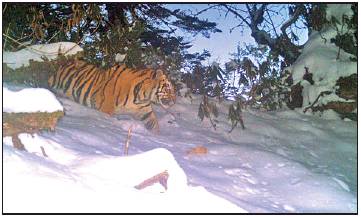
From: Naresh Mitra, Tigers spotted at 3,630m in snow-clad Arunachal valley, December 3, 2018: The Times of India
A three-year camera trap study has reported the presence of tigers in the snow-clad Dibang Valley of Arunachal Pradesh at the height of 3,630 metres. It might be the highest spot at which the big cats have been sighted, but Aisho Sharma Adhikarimayum — a Wildlife Institute of India (WII) scientist — believes that they may be present in even higher reaches of the mountains.
Adhikarimayum of the WII’s department of endangered species management said there was a possibility that the predators were present beyond 3,630 metres in the valley, like in Bhutan, where a tiger was photographed at 4,200 metres in 2012. He was backed by conservationist Anwaruddin Choudhury, the author of several reports on the wildlife of Dibang Valley. Choudhury told TOI there was a distinct chance of tigers being present in the landscape up to a height of 4,000 metres.
Tiger sightings above 4,000 metres have also been reported in Uttarakhand but no conclusive evidence to back the claim has been found so far. If, according to Adhikarimayum and Chowdhury, tigers do exist above 3,630 metres in the Indian part of the Eastern Himalayas, it would significantly add to conservationists’ knowledge about the species.
The camera trap exercise of which Adhikarimayum was a part, along with WII scientist GV Gopi, was carried out in 2015-17 across 336 square kilometre of the total 4,149 square kilometre area of the Dibang Wildlife Sanctuary (DWS).
The study, which was published in the Journal of Threatened Taxa on November 26, not only gave photographic evidence of tigers at 3,630 metres, it also found 11 individual tigers, including two cubs, in the DWS. As per the study, “A total of 108 camera traps were deployed in 336 square kilometre area, with 13,761 trap nights inside and outside the protected area.”
Attacks by tigers
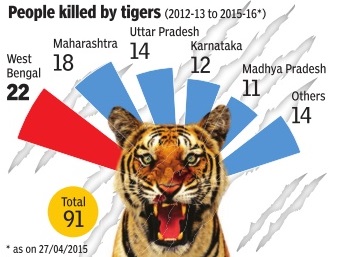
2012-15: 82 attacks
DNA India, 8 Mar 2016
82 incidents of tiger attacking human in 2012-15
Among these incidents, 28 have been reported in 2014-15, 33 in 2013-14 and 21 in 2012-13, he said in Lok Sabha during Question Hour.
Javadekar said the National Tiger Conservation Authority has a multi-pronged strategy to deal with human-wildlife conflict including habitat interventions, restricting habitat interventions, material and logistical support besides others.
Based on the carrying capacity of tigers in a reserve forest, habitat interventions are restricted through an overarching Tiger Conservation Plan, he said.
In case tiger numbers are at carrying capacity levels, it is advised that habitat interventions should be limited so that there is no excessive spillover of wildlife, including tigers, thereby minimising man-animal conflict.
"Further, in buffer areas around tiger reserves, habitat interventions are restricted so that they are sub-optimal vis-a-vis the core tiger habitat areas, judicious enough to facilitate dispersal to other rich habitat areas," he said.
Javadekar said the central government through the National Tiger Conservation Authority has operationalised and funded setting up of Electronic Eye (E-eye) surveillance in Corbett and Kaziranga Tiger Reserves along with Ratapani Wildlife Sanctuary in Madhya Pradesh.
Besides observing the movement of tigers and other animals, E-eye acts as an early warning system wherein movement of poachers and intruders can be viewed before they reach the sensitive areas of tiger reserves, thereby checking any wildife crime.
It also helps in monitoring dispersal of wild animals in human habitations. This facility may be replicated in other tiger reserves also, if needed, he said.
2017: Pilibhit tiger reserve, UP
A tigress killed six people within a 4km radius of Pilibhit Tiger Reserve was tranquillised and taken to Lucknow zoo, another tiger mauled to death a 55-year-old woman on Thursday in the Mala forest range, about 30km from the last six killings.
Sub divisional officer of social forestry and in-charge officer of QRT (quick response team) KP Singh said Kalawati, of Mewatpur village, along with two others had gone into PTR to collect firewood when the tiger attacked and killed her between 2pm and 3pm.
Attacks on and deaths of tigers
What kills most tigers: 2009-16
Priyangi Agarwal, January 1, 2019: The Times of India
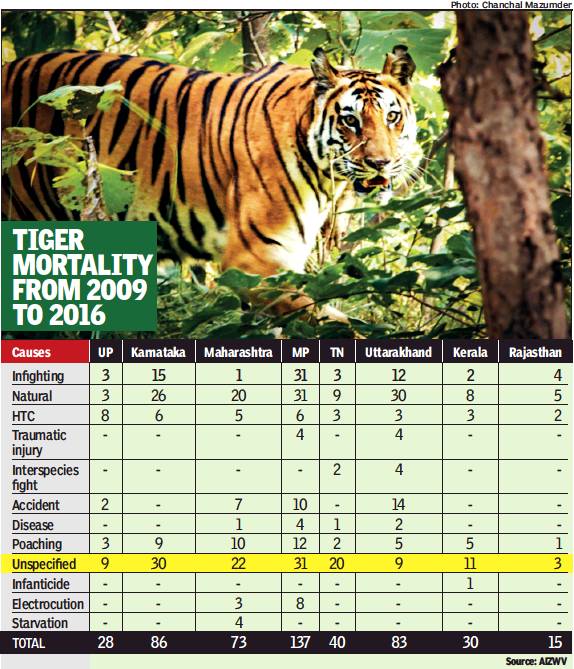
From: Priyangi Agarwal, January 1, 2019: The Times of India
A study by Association of Indian Zoo and Wildlife Veterinarians (AIZWV), which has been compiling a database on wild mammalian species with reference to morbidity and mortality, stated that in most cases of tiger deaths reported from 2009 to 2016, the specific reason could not be ascertained.
According to the association, of the 28 tiger deaths that occurred in Uttar Pradesh from 2009 to 2016, nine were unspecified. Similarly, 30 out of 86 tiger deaths in Karnataka, 22 out of 73 in Maharashtra, 31 out of 137 in Madhya Pradesh, 20 out of 40 in Tamil Nadu, 11 out of 30 in Kerala, nine out of 83 in Uttarakhand and three out of 15 in Rajasthan were due to unspecified reasons.
BM Arora, president of AIZWV told TOI, “We have prepared the report on tiger deaths in forest areas of eight states after collecting data from National Tiger Conservation Authority (NTCA) and through RTI applications. After analysing the data, we found that in most of the states, the specific reason behind a majority of tiger deaths could not be ascertained. In a few cases, the reason is based on opinion or circumstances but the forest department in every state should focus on a holistic mortality investigation. It is necessary to know the accurate reason of death to identify the pattern and work on minimising mortality.”
The association said autopsies of animals should be done near forests. “Veterinarians are unable to diagnose the cause of death if the carcass is decomposed. Timely detection of carcass is necessary. Even post-mortem should be done immediately as much time is wasted in transporting the carcass from inside the forest to elsewhere and completion of formalities. In a few cases, carcasses are sent for autopsy 150 km or more from the forest area,” said Arora.
The association said they are compiling and analysing data of other states too and once they get inputs from the entire country, they will send their report to the ministry of environment and forests with their recommendations.
Poaching: 2012-2014
The Times of India, May 15 2015
In 2012-14, poaching has resulted in the deaths of 74 tigers in the country. The data for poaching, including seizure of tiger organs, shows that 23 tigers, or about 31% of the total, were killed inside tiger reserves while 51 were killed outside these reserves. A state-wise analysis of the data shows that the highest number of tigers were killed in Maharashtra followed by Karnataka and Madhya Pradesh, each of these states witnessing over 10 deaths in these three years
Source: Ministry Of Environment, Forest And Climate Change, * including Telangana.
2012-19
India lost 750 tigers in last 8 yrs, 168 due to poaching, June 5, 2020: The Times of India
As many as 750 tigers have died in the country in the last eight years due to poaching and other causes, with Madhya Pradesh reporting the highest casualties at 173, according to an official data.
Of these total tiger mortalities, 369 were due to natural causes, 168 due to poaching, 70 deaths are under scrutiny and 42 due to unnatural reasons, including accident or conflicts events, it said.
There was also seizure of 101 big cats during the eight year period between 2012 and 2019 by different authorities across the country, the National Tiger Conservation Authority said in reply to an RTI query filed by this PTI correspondent.
In MP during this period, 38 died due to poaching, 94 natural deaths, 19 under scrutiny, six due to the unnatural causes and 16 seizures, the data said. Maharashtra has reported second highest deaths, as it lost 125 big cats during this period. PTI
Poaching doubles in 2016
`29 tigers killed by poachers in 2016' Nov 23 2016 : The Times of India
Twenty-nine tigers were killed by poachers this year compared to 14 such deaths in 2015, environment minister Anil Madhav Dave told Lok Sabha on Tuesday . He added that 98 tiger deaths were reported in the country till November 16 2016.
Twenty-nine tigers out of the 98 died due to poaching and 32 due to natural causes.The remaining 37 cases are under scrutiny to ascertain the cause behind the death, Dave said. Last year, 78 tiger deaths were reported in India.Fourteen of them were killed by poachers.
Besides legal steps under the Wildlife (Protection) Act, 1972 which lays down punishment for hunting in tiger reserves, the minister cited the National Tiger Conservation Authority (NTCA) which takes measures to protect tigers. He said financial and technical help was provided to states under various centrally-sponsored schemes.
Predators attacked, 2012-15
February 19, 2015
Man-eater killed by a joint Kerala-Tamil Nadu Special Task Force in the Gudalur forests along the Nilgiris-Wayanad border after attempts to tranquilise and relocate it for eight days failed. The tiger claimed two victims. National Tiger Conservation Authority norms were allegedly overlooked.
December 29, 2014
A relocated man-eater was killed in Khanapur Taluka of Belgaum, Karnataka, by the state Anti-Naxal Force after it mauled a pregnant woman in the Bhadra Wildlife Sanctuary in Chikkamagaluru district.
August 20, 2014
Tiger shot dead in Chichpalli range of Chandrapur, Maharashtra, by sharpshooters. Seven people had been mauled to death by tigers in six months in Pombhurna village. There was dispute over whether the right man-eater was killed.
December 6, 2013bb
Man-eater was tranquilised and caged in Bandipur, Karnataka, by veterinarians tracking it. It had claimed three lives in surrounding villages. It has been relocated to the Mysore zoo.
5. December 2, 2012
Tiger was shot dead in a coffee plantation in Moolamkavu, Wayanad, by Special Task Force officers. Its victims were a dozen cattle. Maneka Gandhi claimed that the shooting was a "cause to wind up the Wildlife Department" as the tiger was not a man-eater.
2015 (Jan-July): Tiger deaths
The Times of India, Aug 12 2015
Neha Madaan
India loses 41 tigers in 7 mths
Poisoning by villagers, poachers' traps claiming big cats' lives
Tiger deaths persisted in the country despite the Union and state governments' efforts towards conservation. The country lost close to 41 tigers from January until August 9 this year, similar to the count in the same period in 2014, reveals data from National Tiger Conservation Authority and TRAFFIC-India, the wildlife trade monitoring network. The data revealed tigers are dying not just from natural causes, but are also being shot to death by authorities in case of man-animal conflicts.
According to the data, till August 9, 2014, Maharashtra reported three tiger deaths.Among these, one tiger was shot dead by sharp shooters of the Chandrapur police. The count of dead tigers in the state has reached five this year.
Vikas Kharge, secretary Revenue and Forest Department (Forests), told TOI that choosing actor Amitabh Bachchan as the ambassador for its tiger conservation projects is likely to have a positive outcome. “We are yet to finalize the modalities. He is a tiger lov er and his involvement in the project will have a unique appeal for the masses,“ he said.
Kharge added that incidents of tiger poaching have declined in Maharashtra due to an increase in the number of protection measures undertaken. “A special tiger protection force, comprising a team of 120 personnel, has been employed in each of the four reserves of the state. For locals' involvement in saving tigers, we have set up village eco-development committees for community participation in conservation of forest and tigers,“ he said.
States that have reported the maximum number of tiger deaths include Karnataka, Madhya Pradesh, Maharashtra and Tamil Nadu.
In 2014, another cause of death cited was poaching by poisoning using organophosphorous compounds. Other causes included cardio-respiratory failure and retaliatory killing by electrocution near Dhamokar at Bandhavgarh Tiger Reserve, MP.
2016: Jan-June
The Times of India Jun 29, 2016
Avijit Ghosh
MP Fares The Worst With 19 Fatalities
At least 74 tigers died between January 1 and June 26 this year in India. Worryingly, there is also a spike in poaching-related fatalities as 2016 reaches its halfway mark, statistics collated from different parts of India by a well-known wildlife NGO shows. Among these, 14 tigers were electrocuted, poisoned or simply killed by poachers, and much of the carcass was recovered. Police and wildlife authorities also seized skins, bones, claws, skeletons, canines and paws of another 16 tigers during this period, taking the tally to 30, as per figures provided by Wildlife Protection Society of India (WPSI). It is possible that some of them might have been killed earlier but the deaths are accounted for only after the seizures.
Another 26 tigers were “found dead“, a category that includes mortality due to disease, old age or unexplained circumstances. Statistics shows the remaining 18 were victims of infighting (12), tiger-human conflict (2), road or train accidents (3) and fights with other animals (1).
In comparison, 26 tigers fell victim to poachers in the entire year of 2015, according to WPSI. Besides, there were 65 deaths due to other reasons as specified above, taking the overall tally to 91 last year.
However, tigernet.nic.in, a database on mortality of tigers and other key wildlife species across India, offers a different figure. The website puts the figure of tiger deaths so far this year at 52, with another 15 when seized body parts are taken into account. The database is a collaborative effort of the Natio nal Tiger Conservation Authority and TRAFFIC-India, a wildlife trade monitoring network. According to the national census in 2014, the number of tigers in India is 2,226 (minimum 1,945, maximum 2491).
A state-wise look at the 2016 figures indicates that the maxi mum number of deaths (19) occurred in Madhya Pradesh.Maharashtra and Uttarakhand take the second spot with nine fatalities each. Madhya Pradesh also has the highest number of recorded deaths on account of poaching: six.
WPSI records show that in the past three and a half years, tiger poaching and seizure of body parts have been reported from 15 states: Andhra Pradesh, Assam, Bihar, Chhattisgarh, Delhi, Karnataka, Kerala, Madhya Pradesh, Maharashtra, Odisha, Tamil Nadu, Telangana, Uttar Pradesh, Uttarakhand and West Bengal.
Among them, the majority of cases are from Assam, Bihar, Chhattisgarh, Karnataka, Madhya Pradesh, Maharashtra, Tamil Nadu, Uttar Pradesh and Uttarakhand.
Wildlife experts feel intelligence-led enforcement operations are key to thwarting poaching. “We are lacking on this front. Most of the time our frontline staff in protected areas are not even aware of the modus operandi of poachers. International cooperation is necessary to break the criminal nexus and reduce the demand of end-products in China and south-east Asian countries,“ Tito Joseph of Wildlife Protection Society of India said.
Loss of habitat is another issue that ails tiger conservation.The big cat's habitat is now limited to “7% of its original range“, said conservation biologist Raghu Chundawat. “Poaching of the tiger is not the only reason for this (deaths). There are several issues and all these can be referred to as loss of the quality of tiger habitat. This can also include loss of prey , forest cover, connectivity etc,“ he added.
2016/ MP: 33 tigers killed
33 tigers killed in MP in 2016, Dec 30, 2016: The Times of India
An adult tigress was mowed to death by a speeding train in Madhya Pradesh's Hoshangabad district. The accident took place just 32km from the proposed Ratapani tiger reserve. With this, a total of 33 tigers have been killed in MP in 2016.
“It's very unfortunate. We had been requesting railways to slow down trains while passing through forest areas. I have asked officers to examine if there is a provision for taking legal action in such cases,“ said state's chief wildlife warden Jitendra Agrawal.
The Ratapani Sanctuary, spread over an areas of 435 sq km, was established in 1976. In 2008, the National Tiger Conservation Authority gave its inprinciple approval for the creation of a tiger reserve in the area, but the state government has not yet sent its final proposal to the Centre.
Wildlife activist Ajay Dubey said, “Railway ministry has to help resolve the problem to stop such incidents,“ Dubey said.
2016: 122 tiger deaths
Vineet Upadhyay, 122 tiger deaths in 2016, House told, March 6, 2018: The Times of India’'
As many as 122 tigers died of various reasons across the country in 2016, with 32 of the fatalities occurring in Madhya Pradesh, Rajya Sabha was told.
The deaths were attributed to factors like, disease, fights with other big cats, natural death and poaching, among others, Union minister Mahesh Sharma said.
2017, Feb.: Uttarakhand
Vineet Upadhyay, Uttarakhand sees second tiger death in two days, Feb 23, 2017: The Times of India
The body of an adult male tiger was found in Chhoi village of Ramnagar in Terai West forest division of Kumaon on Wednesday , the second instance of a big cat death in the state within two days. On Tuesday , a tiger estimated to be 10 years old, was found dead in the Chidiyapur range of Haridwar forest division. Wildlife activists alleged that the animal was poisoned by the Gujjar community living in the buffer zone of the range although forest officials claimed that the death was because of septicemia -a bacterial infection of the blood. Next day's death meanwhile was attributed to be a fall out of a territorial dispute between two tigers. “The findings of the post-mortem re port clearly indicate injuries inflicted in a territorial fight,“ said Subhash Chandra, divisional forest officer, Terai West. He added that the mating season for tigers was going on, and a fight may have broken out between the two tigers over a female.
Eyewitnesses said that injury marks of claws were found all over the half-decomposed body of the dead big cat and teeth marks could also be observed near its neck and forelimbs.
Since the beginning of this year, deaths of four adult tigers (including Wednesday's fatality) have been reported in separate incidents in the state.
2017: Poaching plays havoc in M.P.
Rahul Noronha , Big cats peril “India Today” 1/1/2018
Four tiger deaths in just 45 days could seriously imperil Madhya Pradesh's push to regain its place as India's 'tiger state'. The fresh big cat mortalities, from unnatural causes, have taken the total number of deaths in 2017 to an unacceptable 25. Fifteen of these deaths were recorded in forest areas in and around the Bandhavgarh National Park.
In the latest instance, on December 11, an adult tigress was found dead near Kachodar in Umaria district. A day later, one of her cubs was discovered, similarly electrocuted by traps laid by poachers. That both carcasses were found three days after the death points to lackadaisical monitoring wildlife officials responsible for tracking the felines in Bandhavgarh clearly had no idea this had happened. In two earlier instances in November, an adult male tiger was found dead near Shahdol after being poisoned while another tiger was found dead after being electrocuted in Dhorai in Umaria district.
Alarmed by the sudden spike in 'unnatural' tiger deaths, the National Tiger Conservation Authority (NTCA) has issued a notice to the MP forest department seeking an explanation. And while the state authority is yet to respond, it has provoked an only too familiar blame game in the state.
Standard operating procedures (SOPs) aren't being followed, says a senior forest official requesting anonymity. "Once you know there is a tiger in the area, there must be enhanced patrolling to check for electrical wire traps, especially in an area notorious for such things," the officer said. According to him, there's no system in place to sensitise the local population because there are few trained wildlife officers in the field. "They are either at headquarters or posted outside the forest department," he said.
Wildlife activist Ajay Dubey also points to the "shortage of boots on the ground because lower level staff is engaged in VIP duties at tiger reserves". Dubey rejects explanations trotted out by forest officials that the traps weren't meant for the tigers. "What kind of an excuse is that?" he asks. "A local, invariably a tribal, is arrested while there is no let-up in the incidents."
Until 2006, Madhya Pradesh was the leading tiger state', with a population of 300 of the big cats. But with rising mortality, it lost the top spot to states like Karnataka and Uttarakhand. Having now run a sustained repopulation campaign, MP is looking toregain its preeminent tiger status after the National Wildlife Census is conducted in 2018. But it will have to find a way to put an end to the poaching.
Encroachments disrupt gene flow of tigers in NE/ 2020
The national tiger census report for 2018-19 has estimated a truncated figure of 219 tigers in the Brahmaputra flood plain and northeast hills due to “poor sampling” and has red-flagged the process of humans cutting off the gene flow of the big cats from the source at Kaziranga, which is crucial for conservation.
The report states, “Tiger occupancy was recorded from an area of 3,312km of forests.”
It underlines that the Brahmaputra flood plains support a high density of tigers and is connected to Orang Tiger Reserve on the west, Nameri, and Pakke tiger reserves in the north through the island systems of Brahmaputra. “The river islands play a vital habitat link to maintain gene flow between plains and hill populations of tigers (in Arunachal Pradesh). But, these islands being fertile for agriculture and pasture for livestock are encroached being a hindrance for animal movement. Kaziranga population has almost lost the connectivity to the north bank of the Brahmaputra.”
Behaviour (of tigers)
Maternal instincts among tigresses
The Times of India, Jun 29 2016
Vijay Pinjarkar
Wildlife experts say tigresses are caring mothers, separating from their cubs only when sure they can take care of themselves, around the age of 17-24 months. However, a popular tigress in Maharashtra's Tadoba Andhari Tiger Reserve (TATR), courting a male for the better part of last week after deserting her three one-year-old cubs, has challenged established ideas about big cats and left experts bewildered.Her anomalous behaviour has set off feverish discussions about her possible motivation, with some experts suggesting the mating may be a mother's ploy to distract the male from attacking her cubs, a two males and one female.
Bilal Habib, a scientist with Wildlife Institute of India (WII), Dehradun, said though unusual, areas with a high tiger density have been witnessing such incidents.“Maya's territory overlaps with that of four males. Mating with them is the best strategy she could have adopted to save her cubs,“ he added, “Had Maya been defiant, her cubs and she could have either been harmed or killed by the other males.“
TATR chief conservator of forests and field director G P Garad backed the view.
According to recent reports, a male tiger named Matkasur is said to have attacked one of the cubs. Naturalist Himanshu Bagde had seen the adult male trailing Maya on June 10 from a water hole. When Bagde reached Pandharpaoni, where Maya lives, Matkasur had charged at one of the cubs, which has not been seen since. Later, Maya was sighted with another male, Gabbar, at the waterhole. There, Matkasur and Gabbar had a fight. The former conceded defeat and moved to the Kosekanar area. After that, for four days, Maya was seen mating with Gabbar. “All I can say is it is evident that there is so much that we don't know about the social behaviour of tigers,“ said Shekar Dattari, a wildlife film-maker.
2018/ 350km: ‘longest distance from home’ record
In the longest tiger dispersal in the shortest time recorded in the country, a young male travelled around 350km from Chandrapur Super Thermal Power Station (CSTPS) in Maharashtra to Palaspani in Betul district of Madhya Pradesh in search of new territory. The tiger is still moving. Now it is 50km away from Melghat Tiger Reserve (MTR) in Maharashtra and 100km from Satpura Tiger Reserve (STR) in MP, according to experts.
“It crossed the busy Amravati-Nagpur NH6, agriculture fields and village roads, and thrice swam across open watery canals of Upper Wardha dam in Morshi before entering Betul district on Monday evening,” said divisional forest officer Harishchandra Waghmode, heading the monitoring operation. Now, MP forest teams too have joined the operation.
Census
Methodology; results of 2006, ’10, ’14
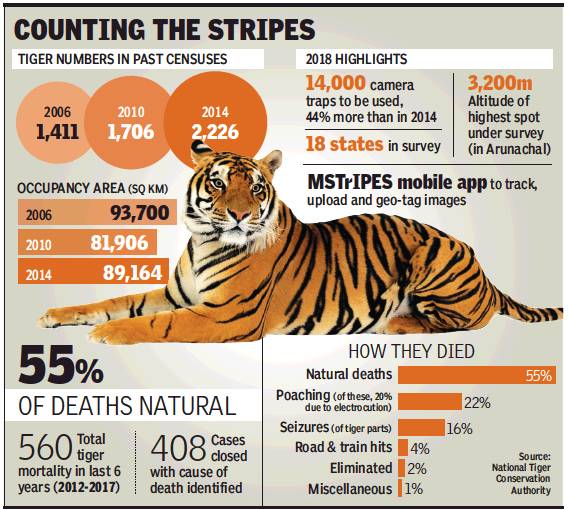
From: Amit Bhattacharya, Tiger census kicks off with more cameras, mobile app, February 7, 2018: The Times of India
Growth Trend In Number Of Big Cats To Continue: Experts
The largest survey of wildlife anywhere in the world has kicked off. Over the next few months, the all-India tiger census 2018 will use more technology, including a mobile app, with more intensive ground coverage and a higher focus on the northeast to determine the country’s big cat numbers.
The last census, in 2014, had estimated India’s tiger population at 2,226, up from 1,706 in 2010. Most experts expect the growth trend to continue. The results are likely to be announced early next year.
The basic census methodology — double sampling based on ground-based surveys for tiger signs and actual images captured on cameratraps, along with statistical extrapolation — remains unchanged. First introduced in 2006 after the previous “pugmark” surveys were found woefully inaccurate, the double sampling method had estimated India’s big cat numbers that year at just 1,411, ringing alarm bells around the world.
Giving details of this year’s exercise, officials from the National Tiger Conservation Authority and Wildlife Institute of India, which conducts the census, said on Tuesday that ground staff involved in the count will be using a mobile app, MSTrIPES, for the first time.
“The app records the staff’s path through the forest and helps upload geotagged pictures into the central database. This will make the exercise speedier and more accurate,” said Y V Jhala, senior WII scientist who heads the census.
This year’s count will use 14,000 camera traps for capturing tiger images, 4,300 more than in 2014. Individual tigers are identified from camera images through a software that records the animal’s unique stripe pattern. The last census had identified 1,685 tigers, 76% of the total, through images from camera-traps deployed in forests across India.
Another big focus of the census will be to cover northeast India intensively, which hopefully will provide more robust tiger numbers from the region. “Due to various reasons, including accessibility and the fact that tigers there are thinly spread over large areas, northeast wasn’t adequately surveyed in past counts although the entire region was covered. We intend to change that this time by using more cameras and gathering evidences like tiger scats from the ground,” said WII scientist Qamar Qureshi.
The census isn’t about the tiger alone. The 2014 exercise had resulted in the first ever estimate of India’s leopard population, which was put at 11,000. “This exercise will go further, giving us estimates of various carnivores, ungulates and other animals in India’s forests,” said Siddhanta Das, India’s director general of forests and special secretary in the environment ministry.
Famous tigers
The Times of India, 14 Jul, 2015
Tigers like Ranthambore's T24 have been hitting headlines of late for attacking humans. Here are famous big cats from around the country.
Collarwali, the mother of 30 cubs/ 2019
With 30 cubs, tigress sets new Penchmark, January 29, 219: The Times of India

Foresters compare Collarwali’s legend to that of Ranthambore’s world-renowned ‘Machhli’ who died in 2016
From: With 30 cubs, tigress sets new Penchmark, January 29, 219: The Times of India
A 13-year-old tigress from Madhya Pradesh’s Pench Tiger Reserve, popularly known as ‘Collarwali’, has given birth to four cubs, making her the mother of 30 cubs born in different litters over the last ten years and which forest officials feel could be a rare record.
Tourists spotted the Royal Bengal tigress ‘T-15’ with four cubs in Pench, field director Vikram Singh Parihar said confirming the births. The tigress made headlines in April 2017 after expanding her litters by giving birth to four cubs.
Asked whether Collarwali has now become the world’s first tigress to have given birth to so many cubs, Parihar said he has not come across such a feline and was verifying if this is true.
Parihar said this was Collarwali’s eighth litter. “(Earlier) it had given birth to 26 cubs in seven litters,” he said, adding that 21 of the 26 cubs born to her are currently wandering in the reserve.
“The tigress is very beautiful. Its eyes and walk sway everyone. It has now given birth at the age of 14, which itself is the most pleasant surprise,” he said, pointing to the 14-15 year average lifespan of tigers. “Collarwali looks young, and going by her beauty and robust health, she might set another record by living beyond 20. Look at the feline, it seems she might survive 22 years!” Parihar said. The tigress was born in September 2005, he said citing official data. PTI
Machli
One of Ranthambore National Park’s most famous tigers, Machli (T16) has been the subject of a number of documentaries and films and received a clutch of awards. She’s known as the ‘Queen of Ranthambore’ and the ‘Lady of the Lakes’ and once dominated the entire jungle. A You Tube video of her battling and vanquishing a 14ft mugger has more than 5 million views. She’s now 19 years old, weak, toothless and possibly blind in one eye, and the park officials feed her to keep her alive.
Munna
Kanha Tiger Reserve’s most famous residents is a tiger called Munna, who can quite easily be identified by his stripes. The marks on his forehead seem to spell out ‘CAT’ and tiger lovers say the ‘PM’ below stands for prime male. Munna has a reputation for following safari vehicles until they pull off the track.
Bamera Male
The son of Bandhavgarh National Park’s best known tiger B2 or Sundar, who died in 2011, this dominant tiger is known only as Bamera male. The story is that he left the reserve he was born in but returned a few years later to battle his father and take it over.
Shivaaji
One of Tadoba Andhari Tiger Reserve’s most famous big cats is the dominant male, Shivaaji. The 13-year-old tiger, known for his bulk and aggression, can usually be seen in a 50sqkm area of the southern I Kolsa range of the park.
Human- tiger conflict
As in 2019
Vijay Pinjarkar, February 12, 2020:: The Times of India
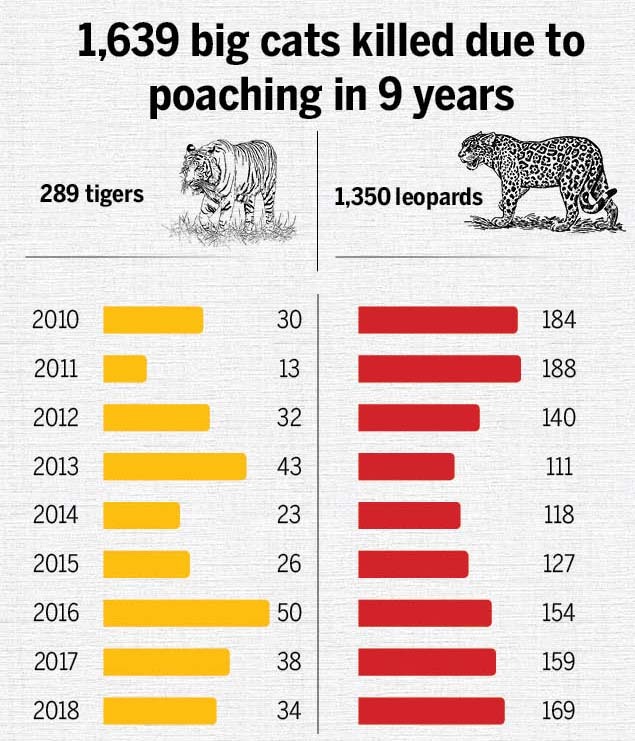
From: Vijay Pinjarkar, February 12, 2020:: The Times of India

From: Vijay Pinjarkar, February 12, 2020:: The Times of India
It was a rescue that came too late. For almost two years, a tigress in Maharashtra’s Tipeshwar Wildlife Sanctuary had been carrying a wire noose around her neck. When the tigress was spotted on March 17 this year, her injury had worsened and maggots had collected around the wound. The animal was so weak she was barely able to move. She died just hours after she was tranquilized by forest officials in a bid to save her.
Barely a month later, another young tigress was found dead -- her neck held tight by the coils of a wire snare -- in the nearby Tadoba-Andhari Tiger Reserve (TATR). And recently, a two-year male tiger was injured after his front paw got trapped in a snare at the Tipeshwar sanctuary.
Every year, tigers and leopards in India are being killed and injured by snares, a threat that doesn’t register when one lists dangers faced by big cats. But in the last nine years, 24 tigers and over 100 leopards in the country’s forests have suffered slow, agonising deaths in these traps.
Sometimes it is organised poachers who lay metal jaw traps to lock in unsuspecting animals, while at others it is local communities that use wire noose snares to kill big cats preying on their livestock. In many cases, felines also become collateral damage in the hunt for bushmeat. But little has been done by respective forest departments to tackle the menace. What’s troubling is the fact that in the latest incidents of tiger deaths in Maharashtra, the snares were laid in core areas of the reserves.
The Wildlife Protection Society of India (WPSI), a non-profit organisation working to combat poaching and illegal wildlife trade, has monitored big cat deaths due to snares for the period between 2010 and 2018. It was WPSI that reported the tiger and leopard deaths apart from multiple instances of injuries to animals.
Experts said that threat from snares needs to be immediately addressed and the forest department should make anti-snare exercises with use of metal detectors a regular part of patrolling. Kishor Rithe from Satpuda Foundation, which works for tiger conservation, said that they had prepared a standard operating practice (SOP) to deal with wire snares in 2012 but it has since been gathering dust.
“We held some training sessions at Chandrapur for field staff but the response was not encouraging. Use of metal detectors in tiger reserves during patrolling could be the first line of defence and help weed out such snares,” said Rithe.
Jose Louies, deputy director and chief, wildlife crime control division and communications, Wildlife Trust of India (WTI), said thousands of animals fall prey to wire snares but the issue only gets highlighted when a tiger or a leopard is caught.
Louies said that earlier local poachers used creepers and bamboo traps to poach wild animals. Now binding wires used in buildings, wires from solar fence and bike clutch cables are preferred because these are low on investment, easy to carry, hide, install and quite effective in capturing a wide variety of animals. “Once installed in an animal path or forage, they will go unnoticed,” he said, adding that anti-snare walks could help prevent poaching in fringe areas.
“WTI and the Karnataka forest department have seized over 2,000 snares since 2012. In Karnataka’s Bandipur tiger reserve, we took the help of people from fringe villages to collect initial intelligence on snaring,” said Louies. In Karnataka, anti-snare drives are now part of the patrolling exercise.
In Maharashtra, forest officials admitted that they have regularly seized snares near Tadoba-Andhari Tiger Reserve (TATR). Divisional forest officer (DFO) Deepak Chondekar, who spent most of his tenure in and around Tadoba and Gadchiroli, told TOI, “Wire snares are widely used to kill animals. When I was posted in Shivni in 2010, I seized over 100 wire traps. In most such cases, there is no prosecution.”
But the death of the tigress in Tadoba reserve did spur authorities into action. Four suspected poachers have since been arrested and frequent anti-snaring drives are being conducted. Maharashtra principal chief conservator of forests (wildlife) Nitin H Kakodkar said, “Periodic anti-wire snare operations will be intensified in park areas with special focus on the peripheries.”
Dr John Goodrich, chief scientist and tiger programme senior director for Panthera, the global wildcat conservation organisation, said, “Direct poaching of tigers and their prey are decimating tiger and prey numbers, especially in south-east Asia. In the short-term, this threatens the existence of tiger populations and even entire subspecies, and in the long-term it renders tigers, their prey, and the ecosystems in which they live less resilient to impacts of climate change and habitat conversion.”
WHY SNARES
Low on investment
Solar fence wire, bike clutch cable most preferred material
Effective
Easy to carry, hide and install to capture many types of animals
Remain unnoticed
Once installed in animal's path, they are not easy to spot
WHAT NEEDS TO BE DONE
Increased anti-poaching patrol, anti-snare walks
Use of metal detectors during patrolling
Training sessions for field staff
Posters/videos to educate public on cruelty of wire snares
Financial award schemes for local informers
Strict action against those who place snares, even if outside Protected Area
Install solar electric fences to reduce crop raids by wild animals, reducing need for snares
The legal position
Movement of humans more important than tigers: SC
The Times of India, Jan 21 2016
Dhananjay Mahapatra
SC: Development more important than tigers
The Supreme Court said that the conservation of tigers was important but it could not be done at the cost of movement of human beings from one place to another and general economic development of the country . The court was critical of NGOs which rush to challenge development projects, in this case four-laning of the 37-km-stretch of NH-7 between Nagpur and Jabalpur passing through Pench tiger reserve.
The issue had led to a tug of war between the Nagpur bench of Bombay high court, which had suo motu taken up the issue of widening of NH-7, and the National Green Tribunal (NGT), which claimed to have sole jurisidiction over environ mental issues. Both passed orders that ran counter to each other, leaving the officials of National Highways Authority of India (NHAI) in a Catch-22 situation. If they obeyed one, they committed contempt of another.
The SC settled the conflict and said the HC would be the forum to deal with the roadwidening issue. A bench of Chief Justice T S Thakur and Justices A K Sikri and R Banumathi was highly critical of NGOs, including Conservation Action Forum, which had challenged the road-widening project on the ground that it would seriously impede the traditional migration routes of tigers in the reserve.
The bench said, “Tigers are important. But what happens to the movement of traffic? It is not the first time that a national highway is passing through a reserved forest. We are for protecting tigers.“
“Have you all filed any PIL against poaching? Why don't you go and work with those people working at the ground level to protect tigers from poachers? You jump to litigation whenever there is a development project. File a PIL on how to prevent poaching. Real danger to tiger is not from road traffic but poachers,“ the bench said.
Uttarakhand
Do not kill man-eating tigers, leopards: HC
The Hindu, December 20, 2016
Please see: Leopards: India
After a tigress was declared a ‘man-eater’ and killed in Uttarakhand’s Ramnagar area, the Uttarakhand High Court on Monday ordered that no wild animals in the State, including tigers, leopards, and panthers, should be killed or declared ‘man-eater’.
“No wild animals including tigers, leopards and panthers shall be declared man-eater or rogue and killed in entire State of Uttarakhand,” the Division Bench comprising Justice Alok Singh and Justice Rajiv Sharma stated.
The Court further ordered that the wild animals who posed a threat to human life must be “captured alive by using a tranquilliser gun in the presence of a veterinary doctor. The captured animal shall be thereafter released in the nearby forest or kept in a zoo temporarily and thereafter released in its own habitat”.
Since most of the killings of man-eating leopards and tigers are done by the State forest department, which hires professional hunters for the task, the High Court stated that no private hunters could now be hired by the State government.
Also, after several instances where elephants have been killed due to electrocution, the HC directed the Railway Ministry to “dig up trenches around the electric poles along the railway track in Rajaji National Park, and also to insulate the electric poles by raising a fence to avoid electrocution.”
Project Tiger
1973: Project Tiger
India Today December 29, 2008
The Rs 230-lakh Project Tiger was a Union Government and the World Wildlife Fund joint endeavour in 1973, to check immediate threats to the national animal. “It registered a marked increase in most animal populations in the first decade” (India Today, December 1983). With 1,550 sq km under its canopy, including 15 sanctuaries and national parks, the project cordoned off a third of this land for conservation activities and demarcated the rest as a buffer area, relocating the villages around.
2016-17: increased funding

The Times of India, Mar 02, 2016
Amit Bhattacharya, Vishwa Mohan & Indranil Basu
In the biggest budgetary boost for the tiger in recent years, the Centre has hiked its allocation for Project Tiger by nearly 80% for the coming fiscal year, utilising funds collected from the cess on coal, lignite and peat. The Union Budget has approved an allocation of Rs 300 crore for Project Tiger for 201617, up from Rs 168 crore the project had received in the current year. The enhanced funding will come from the `clean energy cess', which the government, in its Budget, increased from Rs 200 per tonne to Rs 400. It has also been renamed the `clean environment cess'.
The cess, to be deposited in what will now be called the national clean environment fund, will be used not only to develop renewable energy sources, but also to fund various environment protection measures, including Project Tiger, wildlife conservation, abatement of river pollution etc.
Allocations for the tiger had been slashed by 13% in the last Budget, leading to accusations by wildlife activists that the Modi government was neglecting the conservation of the striped cat.
The huge increase in funds for 2016-17, however, comes with a catch. The finance ministry has stuck to the condi tion, introduced last year, that the respective states contribute 40% of the non-recurring expenditure on tiger reserves.
As per the earlier funding pattern, the Centre provided 100% of non-recurring expenses -which includes compensation for villagers relocated from tiger habitats, equip ment for the special tiger protection force etc -while the recurring costs were shared equally by the Union government and the state where the tiger reserve is located.
“During 2015-16, many states were caught unawares by the change in funding, and crucial projects couldn't be implemented.With the enhanced funding, both the Centre's and the states' share will increase.Which means, states with tiger reserves should prepare to increase their allocations,“ a source said.
An official said Project Ti ger funds for the next fisca would also be used to host the next Asia ministerial confer ence on tiger conservation here. The three-day meet will be inaugurated by Prime Minister Narendra Modi on April 12.
According to the 2014 tiger census, India has 2,226 tigers with the three southern states of Karnataka, Tamil Nadu and Kerala of the Western Ghats landscape recording nearly one-third of the coun try's big cats.
India has over the years re corded an increase in its tiger population. If one compares the 2014 figure with that re corded in 2006, the increase across the country has been phenomenal with over 800 more tigers recorded two years ago. The country had 1,411 ti gers in 2006, with 1,706 record ed four years later in 2010.
Protection measures, aggressive
2009/ ban on night traffic
With ban on night traffic, Bandipur road kills down, July 25, 2018: The Hindu
They drop from 93 between 2004 and 2009 to eight in last four years
There is a significant reduction in the number of road kills in Bandipur ever since the ban on night traffic through the tiger reserve was introduced in 2009.
There were as many as 93 wildlife deaths from 2004 to 2009 before the ban on night traffic on the two national highways cutting through the tiger reserve — one connecting Gundlupet and Wayanad, and the other connecting Gundlupet and Ooty — was introduced.
The number declined to 34 between 2010 and 2018 once the ban came into effect, as per the statistics maintained by the Bandipur Tiger Reserve.
Ambadi Madhav, Director, Bandipur Tiger Reserve, said there were as many as 32 deaths in 2004, which increased to 41 in 2007. But once the ban on night traffic came into effect, there was a steady decline in the number of animals being killed by speeding vehicles, he said. Statistics indicate that eight animals have died in the last four years and only one death was reported in 2016.
“Before the introduction of night traffic ban, there were instances of mega carnivores and elephants being killed by the vehicles. But it is no longer the case ever since the introduction of the ban, and most deaths pertain to the spotted deer that are found in plenty,” said Mr. Madhav.
The year 2004 was the worst as far as road kill was concerned: an elephant was mowed down by a speeding vehicle while other animals classified as highly endangered, such as palm civet, jungle cat, leopard, tiger, and sloth bears too died under similar circumstances.
Case in SC
Traffic has been banned through the tiger reserve from 9 p.m. to 6 a.m. following a directive issued by the Chamarajanagar district administration in 2009. This was challenged in the High Court of Karnataka, which upheld the decision and the issue is now pending before the Supreme Court.
The Supreme Court had directed that a committee comprising officials from the Transport Department of Karnataka and Kerala and the Centre, apart from representatives of the National Tiger Conservation Authority (NTCA), be constituted to study the issue.
Mr. Madhav said the committee members visited Bandipur three months ago and conducted an inspection.
P. Sridhar, PCCF (Head of Forest Force), said the State was firm on maintaining night traffic ban through Bandipur in the interest of wildlife conservation. “We have already conveyed our stance to the apex court which is hearing a petition filed by Kerala and stakeholders from the transport sector. Even the NTCA was supportive of our actions,” he added.
2017/ BBC banned for 5 years
Vijay Pinjarkar, Kaziranga report gets BBC banned, Feb 28, 2017: The Times of India
Stung by a BBC documentary questioning India's aggressive protection measures at Kaziranga national park in Assam, the National Tiger Conservation Authority (NTCA) that governs all tiger reserves in the country has imposed a ban on the network and its journalist Justin Rowlatt for five years.
As reported by TOI on February 15, BBC's South Asia correspondent Justin Rowlatt's documentary titled `One World: Killing for Conservation' on Kaziranga's rhino conservation methods came in for sharp criticism from the Union environment ministry for being “grossly erroneous“.The documentary claimed forest guards in Kaziranga had been given powers to shoot and kill anyone they think was a threat to rhinos.
In a memorandum is sued on Monday , NTCA said BBC had failed to submit the documentary to MoEFCC and the MEA for obligatory previewing. It has asked chief wildlife wardens of all tiger range states and field directors of tiger reserves to disallow filming permission to BBC in any of the protected areas for a period of 5 years.
Seizure of tigers, and parts
2000-2015: India recorded most seizures
records highest number of tiger seizure: Report, PTI | Nov 16, 2016
According to a report by wildlife trade monitor, India has recorded the highest number of seizure of tigers and parts among all 13 tiger range countries
The report said India has observed a rapid decrease in number of seizures reported since 2010.
The highest number of seizures was recorded in 2009 & the lowest in 2013.
KOCHI: India has recorded the highest number of seizure of tigers and parts among all 13 tiger range countries, accounting for 44 per cent, according to a report by wildlife trade monitor released.
Titled 'Reduced To Skin And Bones Re-Examined: Full Analysis', the report said such incidents of smuggling of tiger and tiger parts reveal failure of tiger range countries in ramping up enforcement, closing tiger farms and strengthening laws.
"India, the country with the highest population of wild tigers globally, also recorded the highest number of seizure - a minimum of 540 tigers seized over 16 years," said the report, which is a comprehensive analysis of 16 years.
The report prepared by TRAFFIC, the wildlife trade monitoring network, has found all tiger range countries continued to grapple with the persistent problem of the big cat being removed from the wild and on ways to break the chains of supply and demand.
"During the 16-year period under review, India had recorded the greatest number of seizures of all tiger range countries, accounting for 44 per cent of the total. It reported seizure of a minimum of 540 tigers and a maximum of 622 tigers, the minimum accounting for 30 per cent of the total," it said.
The report, released on Wednesday on the eve of international conference on illegal wildlife trade being held in Hanoi, also said in contrast with the other countries, India has observed a rapid decrease in number of seizures reported since 2010.
The highest number of seizures was recorded in 2009 and the lowest in 2013.
"While the overall number of tigers seized has decreased, the proportion of skins seized remains a high proportion of the seizures but to a lesser degree," the report said, describing Indian scenario.
The report, which showed the location of all reported seizures in India with spot details and a map, has illustrated "three hotspots, the greatest comprising the states of Kerala and Tamil Nadu".
It said these issues existed to varying degrees across all the 13 Tiger range countries scrutinized, evidenced by the minimum of 1,755 tigers seized from 2000-2015, an average of more than two animals per week.
Encroachment of land of forests is the biggest enemy of not only tigers but other species like Rhino ,Lion & Indian Bustard etc.
Kanitha Krishnasamy, Senior Programme Manager for TRAFFIC in Southeast Asia and a co-author of the report, said laws in most countries are weak and without fundamental structures in place, success of any enforcement action is greatly undermined.
"Wild Tiger range countries must step up their game to beat the odds of extinction," Krishnasamy said.
Species
The Panthera tigris, and its habitat
Where are tigers found in the wild [in South Asia]?
In the wild, tigers are found in India, Nepal, Bhutan and Myanmar. The surviving sub species of tiger include:
Indian Tiger or Royal Bengal Tiger (Panthera tigris tigris) found in India, Nepal, Bhutan and Bangladesh;
Indo-Chinese tiger (Panthera tigris corbetti) is also found, inter alia, in Myanmar
The three sub species of tigers that became extinct in the [1900s] include: the Caspian Tiger (Panthera tigris virgata) that was found, inter alia, in Afghanistan.
What is an Indian tiger?
The tiger has an orange coat patterned with broad black stripes. It has black ears, each with a winking white spot on the back, powerful forepaws, and a long banded tail. The total length of the tiger from the tip of its nose to the end of its tail is between 2.6 to 3 meters and it weighs anywhere between 135-280 kgs. The average life span of a tiger in the wild is about 14 to 16 years.
The Indian/Bengal tiger is found mainly in India, Nepal, Bhutan and Bangladesh. The diet of an Indian tiger mainly consists of large wild ungulates such as chital (Axis axis), sambar (Cervus unicolor), barasingha (Cervus duvacelii), nilgai (Boselaphus tragocamelus) and gaur (Bos gaurus) and other animals such as the wild pig (Sus scrofa). It is an opportunistic feeder and can also kill large prey such as elephant calves (Elephas maximus), gaur (Bos gaurus) and wild buffalo (Bubalis arnee). Tigers may occasionally also kill sloth bear and leopards as well as smaller prey such as peafowl, langur, jungle fowl, hare etc.
Due to their large body size tigers are not good tree climbers like leopards. They can only climb along large leaning trees. But tigers are excellent swimmers and love water. Tigers are known to swim between islands in the Sunderbans.
Where do you find tigers in India?
Tigers are found in a variety of habitats, including tropical and sub tropical forests, evergreen forests, mangrove swamps and grasslands. In India, tigers are found in 19 states. For the better management of tiger habitats, forests have been demarcated as Tiger reserves, National Parks and Wildlife Sanctuaries, also known as Protected Areas. There are 39 Tiger Reserves in our country today, some of which were added recently. For more details about the tiger reserves visit www.projecttiger.nic.in
What are white tigers?
White tigers are not a separate sub-species, but are white in color due to an expression of recessive genes. Interestingly, the white tigers are found only among the Indian tigers and can only be seen only in captivity now. The last white tiger reported in the wild was captured in the forests of Rewa in the state of Madhya Pradesh. The white tigers found in the zoos today are most likely descendants of this one tiger that was caught from the wild in Madhya Pradesh and later bred in captivity. White tigers have pink noses, white-to-cream coloured fur, and black, grey or chocolate-coloured stripes. Their eyes are usually blue, but may be green or amber.
Tiger disappearance
2004-09: Lack of space linked to tiger disappearance?
The Times of India, Mar 22, 2016

Jayashree Nandi
Tigers need much more space than our protected areas or tiger reserves provide for currently. While that's true for all wildlife, a recent study published this month in Biological Conservation journal has highlighted how lack of space could be linked to a fast disappearance of tigers from certain habitats, particularly tropical dry forest areas. Sariska and Panna tiger reserves, both tropical dry forests experienced complete extinction of tigers in 2004 and 2009; the study explains what may have led to their complete disappearance.
Some tigers have been re-introduced in Panna and Sariska.
The study documents the space requirements of tigers in Panna tiger reserve before the extinction of tigers only to find a major mismatch in scale of their ranges and the sanctuary size, which exposes tigers to various anthropogenic threats including poaching and retaliatory killings outside the boundary. The reason for such large home ranges of tigers in tropical dry forests is still being studied, authors said but could be linked to ecological factors like prey population, water or shade. The study involved field studies between 1996 and 2005 that monitored tiger movement through radio telemetry and direct sightings in the 543 sqkm area of Panna. Annual home ranges of both male and female tigers were estimated and then overlaid on the sanctuary area boundary revealing how home ranges often breached the sanctuary boundary. According to the authors, this is the first comprehensive study of tiger home ranges in a tropical dry forest area and one of the longest studies on tiger in the sub-continent. The study documented detailed information on six radio-collared tigers over a period of nine years. While conducting the nine-year observations, the team also found some intriguing features. For instance, "Male tiger territories were not exclusive as generally believed. Instead, it was observed that females mated with several males in addition to the territorial tiger. But the role of these non-territorial males can be important but little is known about these tigers," said Raghu Singh Chundawat, lead author of the study.
The team concluded that home range of breeding or nursing tigers extended beyond the boundary of the sanctuary.
In fact what happened in Panna and Sariska are a part of a larger trend, researchers warned. The largest tiger habitat in India is in tropical dry forest category. But the probability of survival of tigers in these areas is much lower than in other habitats like tropical moist forests, alluvial grasslands or mangroves. Interestingly, more than 85% of the sanctuaries located in tropical dry forests are way smaller than Panna and have either lost the tigers already or sit with high risk of tiger extinction.
Quite sad. Unfortunately, with the current environmental policies, or lack thereof, there doesn't seem to be any probability for the long term survival of tigers in India.
"The bottom line is that tigers need more space, and one may need to think out of the box, if tigers are to have a future in the already stressed landscapes," said Koustubh Sharma, co-author of the study. The study recommends that a straight forward solution to the problem will be to protect larger forest areas but that's a difficult proposition in human dominated areas. "Small patches embedded in large landscapes can be conserved as a series of stepping stones to interconnect populations," the study said.
2009-19
Anindo Dey and Ajay Singh, March 2, 2020: The Times of India
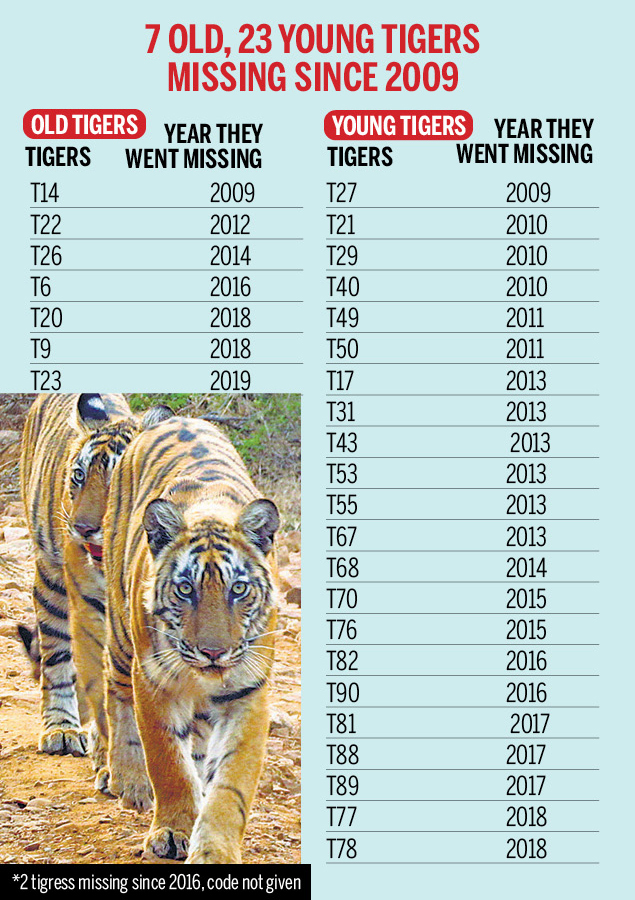
From: Anindo Dey and Ajay Singh, March 2, 2020: The Times of India
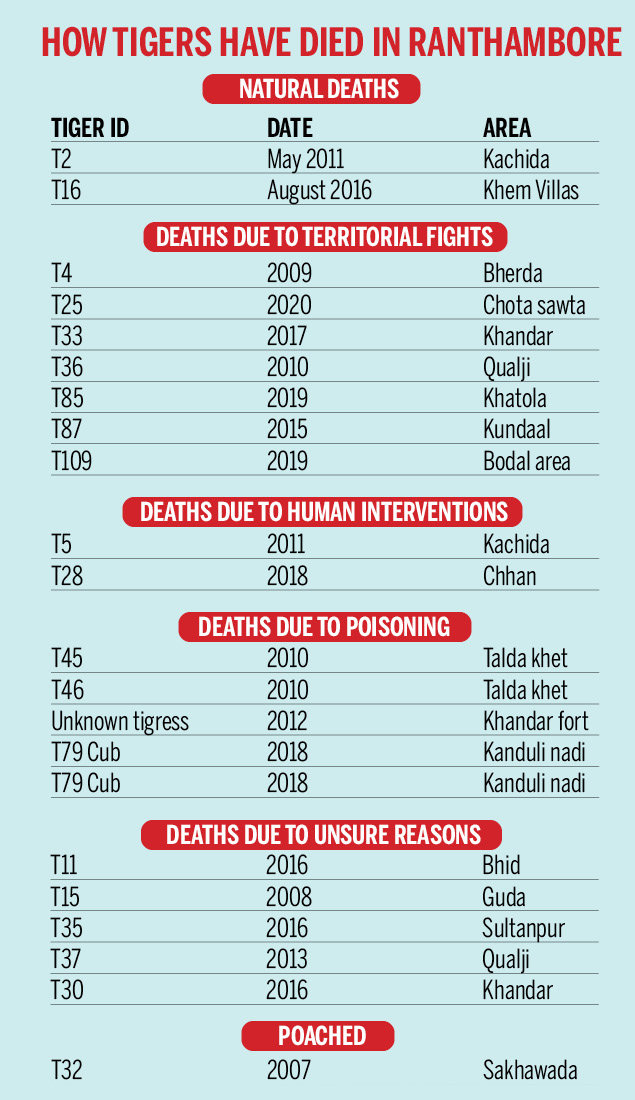
From: Anindo Dey and Ajay Singh, March 2, 2020: The Times of India

From: Anindo Dey and Ajay Singh, March 2, 2020: The Times of India
As the vehicle manoeuvres through the mud tracks in sun and shade, it first spots the sudden bark of the sambhar as monkeys scurry up the trees. Soon, the gold and black haze visible through the bush becomes clear as the tiger steps out. It’s what dreams are made of and the Ranthambore Tiger Reserve (RTR) has over the years gained ‘notoriety’ for fulfilling them.
It is the draw for thousands of tourists as they pour in from all corners of the world. “I have been to Kanha Tiger Reserve in Madhya Pradesh, Botswana in South Africa and several other parks across the globe. But the sightings in Ranthambore are the best. The dry, deciduous forest here makes sightings easier. Besides, sighting a tiger in the wilderness is a class apart,” said an excited Mustafa Alam Khan, a tourist from Hyderabad who chanced upon two tigers during his morning safari.
He is not alone. The scores of smiling faces as vehicles escort tourists out after a safari speak volumes of their 'date' with the tiger. But the smiles, warn experts, may be short-lived. With an alarming 30 tigers going missing from RTR in the last decade, it may not be long before the reserve loses its sighting-friendly tag to some other park unless immediate steps are taken.
Since 2009, the park has mysteriously lost seven old and 23 young tigers. Among the 23 are 11 females which do not usually venture out for creating a territory, like the males. In the past two years alone, five tigers have gone missing — T-9, T-20, T-77, T-78 and T23.
This data, however, does not include 22 other tigers that died — some of which were natural deaths and whose bodies were traced or those that were killed in territorial fights, due to human intervention or were poisoned by villagers. There were also some cases where the cause of death still remains a mystery. In addition, 18 tigers were either shifted to Sariska and Mukundra reserves or had migrated to other forests outside the state or been put into captivity due to “abnormal” behaviour.
Two areas in the reserve were of particular concern. “A careful analysis of the data on missing tigers reveals that over the years, the reserve has developed two black holes in the north-east and south-east areas of the park adjoining Sawai Man Singh sanctuary. Most of the tigers that went missing were last sighted in these areas,” said conservation biologist Dharmendra Khandal of Tiger Watch.
One of the black holes identified is in the region between Sanwata and Quila Khandar with its centre at Banpur. The other is the Kanduli, Kharda Ka Nala and Bhairupura region. In the first black hole, 11 tigers went missing after being sighted, while the second black hole saw eight tigers go missing. About 60% of all tigers went missing from these two areas of the park.
Both these areas are natural outlets from the reserve but adjoin 13 villages. Officials conceded that big cats venturing out of the park through nullahs was a menace. Because the land here is fertile and there is plenty of water, extensive farming took place. “These natural nullahs open towards the Chambal area which is surrounded by villages. The farmland is owned by villagers and tigers are at risk if they venture outside. We have also deployed additional guards at the post, but cannot restrict the animal walking out through natural path,” said Ranthambore divisional forest officer Mukesh Saini.
To keep animals away, villagers electrified fences, but were often themselves victims of electrocution. "After the deaths of two villagers due to electrocution, subsequently, bodies of two tigers — T-45 and T-46 — were found in Khandar. Both deaths were due to revenge killing. Bombs used as baits for animals have also been recovered from these areas as was a snared leopard once,” said Khandal.
Another reason for the missing tigers was because their deaths often went unreported. “Villagers lay traps and tigers get killed. The body is then quietly buried as they do not want to get into trouble. Sometimes, it is also a case of migration to other states with officials not following it up,” Khandal said.
“However, we would soon constitute a committee to ascertain the exact number of missing tigers from the park,” he added.
But despite the growing vulnerability of tigers at the park in recent years, there was little support for an already over-worked forest department. “Not only are we under-staffed, but are always catering to VIP tourists’ safaris throughout the year. Most of our seven jeeps and our staff have to be deployed for VIP duty as requests pour in from the high and mighty. Special forces like the Special Tiger Protection Force, which was to be developed, have remained a pipe dream,” explained forest officials.
Suggestion were quick to pour in for better safety of tigers. "Some of the prevailing chokis or nakkas have become redundant over the years and they need to be placed more strategically. Lakarda, Sultanpur, Chandali, Berda should be relocated. Night patrolling, that last of which took place in 2017, should be resumed. The department must also maintain a log book of sightings and develop an intelligence network in the park so that more information is forthcoming. Vehicles for patrolling and those for VIP safari must be separately earmarked," officials suggested.
Former honorary wildlife warden Balendu Singh, however, felt it was natural for tigers to go missing because of the large landscape. "Tigers straying is a natural process. The reserve still has 51 tigers in Division I of RTR which itself is a success story," he said, going to on add, "However, if there are incidents of poaching it is a matter of grave concern and should be promptly looked into.”
Tracking the tiger population
India Today.in , Counting the big cats,one photo at a time “India Today” 15/12/2016
1995
Tiger tracking
Counting the big cats,one photo at a time
How do you count the number of tigers in a jungle? Before 1995, the accepted method was for trackers and gamekeepers to enter the forest, and count the number of unique pug-marks that could be found. Aside from being imprecise and difficult to verify, such methods also put those who undertook such studies at great risk. In 1995, a Karnataka-based conservation zoologist, K. Ullas Karanth, suggested that instead of the laborious, once-every-five-years 'headcount' undertaken by the Ministry of Environment and Forests, camera traps and statistical models should be used. A camera trap is essentially a camera equipped with a motion sensor. After a network of such cameras has been installed in the forest, the data gathered is then put through a rigorous statistical analysis to produce an estimate of the tiger population.
The M-STRiPES app/ 2017
R. Krishna Kumar, November 21, 2017: The Hindu
Field data collection for tiger enumeration in the country is set to go digital in order to reduce human error and provide more reliable estimates. In the All-India Tiger Estimation, to be taken up in December-January, the authorities plan to eliminate the process of manual recording of signs of the carnivore and other habitat details.
Instead, an app named M-STRiPES (Monitoring System For Tigers-Intensive Protection and Ecological Status) developed by the Wildlife Institute of India, Dehradun, will be used for the first time. Though the app has already been in place in some national parks, its usage and application has been made mandatory only now, for the fourth All-India Tiger Estimation.
P.S. Somashekar, director general of the National Tiger Conservation Authority (NTCA), southern region, told The Hindu that the use of the app would ensure a more robust estimate. “All these years, data pertaining to carnivore signs, pellets and status of habitat was manually recorded in the prescribed format on a paper by the field staff, but this exercise was prone to errors. With the availability of M-STRiPES, human error will be eliminated,” he said.
It is a free app that will be made available to staff participating in the tiger census exercise, and they will feed in their observation during the carnivore sign survey and transect marking. Details such as pellet density, vegetation status and human disturbance, if any, will also be recorded.
Training for staff
The field staff and senior officials of the Forest Department will be trained on how to use the app at a programme in Bandipur and Mudumalai from December 5 to 7.
Ambadi Madhav, director of Bandipur Tiger Reserve, said: “This programme will [be to] train the trainers, and they in turn will impart the skills to junior staff in their jurisdiction.” Besides, key technical staff involved in operation of the software will undergo an advanced training course in Delhi in December.
Use of the app in habitat monitoring is not new. Bandipur had Hejje or Pugmark, an Andrioid-based app, while BRT started with Huli. The GIS-based app will give real-time data on forest habitats besides providing live update of monitoring and patrolling activities. But the nationwide introduction of M-STRiPES paves the way for greater standardisation and elimination of inconsistencies in data interpretation.
Counted every four years
The national tiger estimates are conducted once in four years, with the first conducted in 2006. That exercise pegged the tiger count at 1,411, with the statistical lower limit pegged at 1,165 and the upper limit, 1,657. In 2010, the count changed to 1,706, with 1,520 being the lower limit and 1,909 the upper limit.
In 2006, Karnataka accounted for 290 tigers, with a lower limit of 241 and an upper limit of 339. In 2010, the count was 300 tigers, with the lower limit pegged at 280 and the upper limit, 320.
The Western Ghat landscape, comprising Karnataka, Kerala, Tamil Nadu and Goa, accounted for 776 tigers in 2014, with the Bandipur-Nagarahole-Mudumalai-Wayanad complex harbouring 570 tigers — reckoned to be the world’s single largest tiger population in a landscape.
The last nationwide assessment, held in 2014, pegged the tiger figures across the country at 2,226. Karnataka alone was home to 400 tigers, a bulk of them in Bandipur and Nagarahole.
